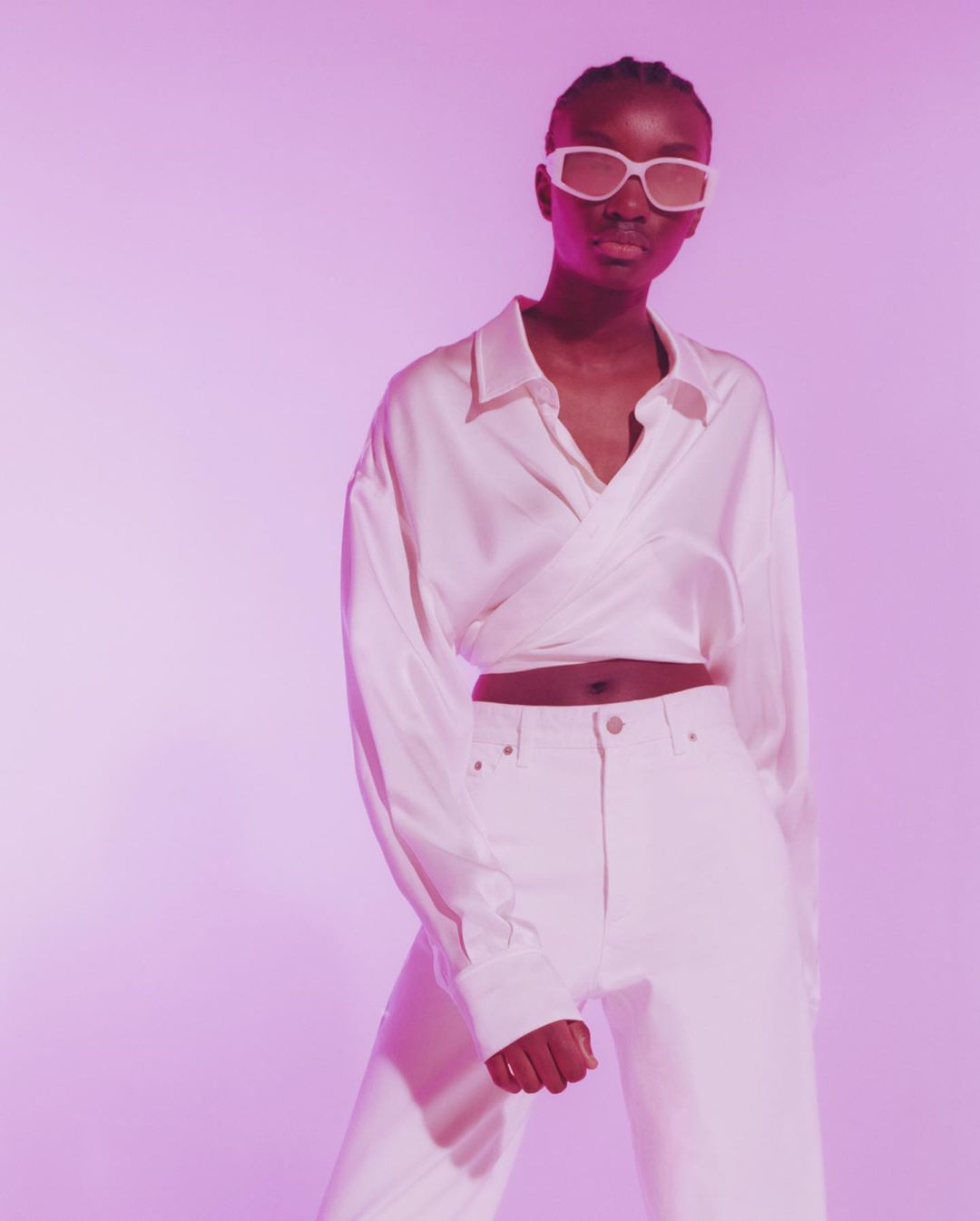The digital transformation of the fashion industry: Fad or future?
While the digital transformation of the fashion industry began years ago, the past year has kicked this change into high gear, fueling new, innovative solutions to longtime challenges.

Table of Contents
1. Breaking down digital transformation
Digital transformation is the process of transforming systems and strategies within a business through digital means. The fashion industry has broadened its digital transformation to accommodate new and longstanding challenges.
2. Digital transformation of fashion consumers and commerce
E-commerce has grown exponentially. This means that for many brands, their e-commerce strategy must be fitted to the rising digitalization and personalization of consumers' shopping habits and demands.
Social media has occupied a highly influential role in fashion in the last 10 years, and it has become even more powerful over the past year. Consumer values are shifting, and brands must adapt to cater to their customers.
Physical stores are looking to create an experience that relates more to online. Personalization and digitalization have become necessities for consumers, and they don't want to sacrifice their experience while shopping in person.
3. Organizational transformation
The value chain entails all activities or processes which create or add value to the product, from design to distribution, and there are many digital solutions to revolutionize this process.
B. Aligning and transforming teams
Digital transformation isn't just about adding technology into the mix -- it's also about a change in mentality and manner of working. Beyond transformation, this can also help to better align teams.
4. Addressing changing values with digital solutions
When we look at the range of possibilities in digital innovations today, it seems fashion isn't doomed to be unsustainable. The technologies fashion now has access to are opening up opportunities for sustainability at every corner.
The fashion industry is finally taking action to make fashion a better space for everyone. With digital solutions like 3D design, digital clothing, virtual models, and more, fashion may one day be as diverse as those who follow it.
5. The digital transformation of the fashion industry: The sky's the limit
The fashion industry is in the age of digital transformation, as more and more digital innovations are becoming available to fashion companies. Changes in consumer demands, market behavior, and technology are responsible for the industry's necessity to adapt. Social media, online and in-store shopping, and resell are growing arenas in which fashion brands must listen to their customers, and respond with digital solutions and new mentalities. Supply and value chains grow more complex each year, but technological innovations are stepping in to create an industry that is more efficient, human, and sustainable.
Breaking down digital transformation

@ireneisgood
Over the course of the past year, businesses in nearly every industry have had to accelerate their digital transformation to accommodate new challenges:
- Shift to online channels
- Improvement of steps along the value chain
- Alignment of teams
- Adaptation to consumer values
These are part of a worldwide digital transformation that was bound to happen, albeit at a much slower pace. Digital transformation is the process of transforming systems and strategies within a business through digital means. Like any form of change, particularly those that occur rapidly, digital transformation has led to the widespread reconsideration of current and traditional ways of conducting business. This is especially poignant in the fashion industry, where the intersection of creativity and data have given rise to fresh challenges, and even fresher solutions.
To understand the digital transformation of the fashion industry, it's important to first understand the part that Covid-19 has played in this phenomenon.
Prior to the pandemic, digitization and fashion were not, by any means, strangers to one another. Data-integrated supply chains, AI-assisted design, tech-infused brick-and-mortar stores, and more already existed for some brands and retailers. Digital transformation can even be as simple as switching from paper to digital, or launching an e-commerce site. What makes this phenomenon worth discussing, then, is that it was predicted to occur slowly over time. Covid-19 accelerated this shift tenfold in the fashion industry, and even more significantly, normalized and democratized the idea of going digital.

That said, brands and retailers have dealt with digital transformation differently over the past year, each in their own way. According to McKinsey's State of Fashion 2021, 45% of fashion executives identify Covid-19 as the biggest challenge this year, and 30% see going digital as the biggest opportunity. Brands' existing business model, company culture, brand identity, and strategy have informed their path of digital transformation, with some transforming top-to-bottom, and others in bits and pieces. Regardless, one thing is certain: those who are more digitally-savvy have an objective advantage over those who are less so. According to McKinsey and Co., when we look through the lens of digital transformation there exist two types of fashion companies today:
- Digital leaders: Online sales make up 30-40% of total sales, the value chain is significantly digitized, and online and offline channels are integrated to some extent
- Laggards: Online sales make up less than 20% of total sales, the value chain has low levels of digitization, and online and offline channels are largely separated
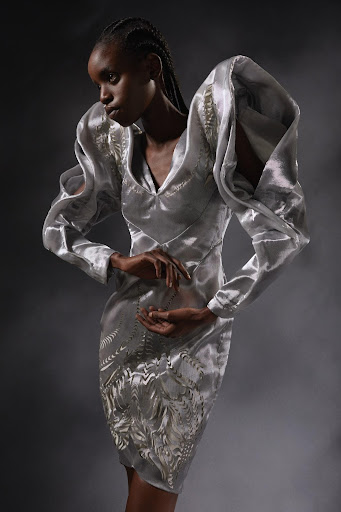
Iris Van Herpen

Rahul Mishra

Azzarro
Any company, no matter their development stage, can turn to digital transformation moving forward.
Laggards do have more room for improvement than their counterparts, so it becomes much easier to digitize if desired. The rapid integration of new technologies is a significant competitive advantage for companies in both stages, though, so the mantra remains the same: adapt quickly, or risk falling behind.
Why is digital transformation important?
According to Statista, the global apparel market is projected to grow in value from $1.5 trillion USD in 2020 to $2.25 trillion USD by 2025. This exponential growth could potentially lead to more serious consequences for the planet, increased complications in global supply chains, greater difficulty establishing efficiency within fashion brands and retailers, and rising consumption by people around the world. Digital transformation exists to:
- Adapt online and in-person shopping to the modern consumer
- Improve steps along the value chain, including the supply chain
- Transform and align teams within a fashion company
- Render existing processes more sustainable
- Address new consumer values such as transparency and inclusivity

iD Fenty, Hanna Moon
This is why it's important to look to new solutions to long-time challenges: digital transformation offers precisely that. We'll be looking into many aspects of the fashion industry to evaluate how different digital solutions can remedy respective issues, from new ways of shopping to shifting team alignment, to operating sustainably, and more.
Digital transformation of fashion consumers and commerce
E-commerce
Today, e-commerce has become an indispensable tool in the industry. So indispensable, in fact, that a growing number of brands have no brick-and-mortar store at all. The proportion of purchases that consumers are now making online as opposed to in-store is proof that shopping has fundamentally changed since the start of the pandemic: a 2021 report affirms that 43% of consumers who had never purchased clothing online began doing so during the past year.
But of course, the widespread store closings have much to do with these numbers. That said, a report from Kibo found that 30% of Gen Zers and 36% of Millennial consumers expect to purchase less at physical stores than before. While it's difficult to predict such behavior, there has been an objective digital transformation in e-commerce over the past twelve months.
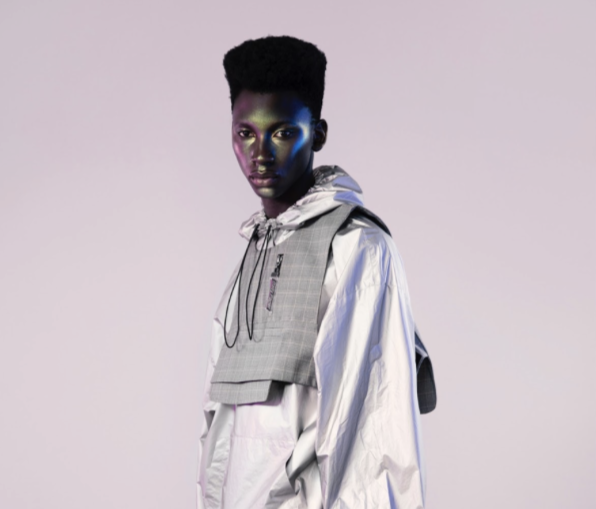
Daily Paper FW19
The rapid growth of e-commerce has pushed fashion brands to seek out new data, and new forms of collecting data.
Everything from customer profiles to UX design to supply chain management has become implicated in e-commerce. According to Euromonitor International, global online retailing will grow by $1.5 trillion USD by 2024. This growth must of course be chased by reliable sources of data, which vary depending upon one's audience, brand identity, geography, and existing business model.
For instance, an online brand may seek out sources like consumer navigation on the site in order to make product recommendations, while a private label retailer may look to past sales history, top brands, and price ranges to make product recommendations. Evidently, sourcing has changed, and consumers' attention has turned to the Internet when it comes to shopping, a natural progression of the industry-wide digital transformation. This is where social media comes in, and why's such a major arena for e-commerce and interaction.
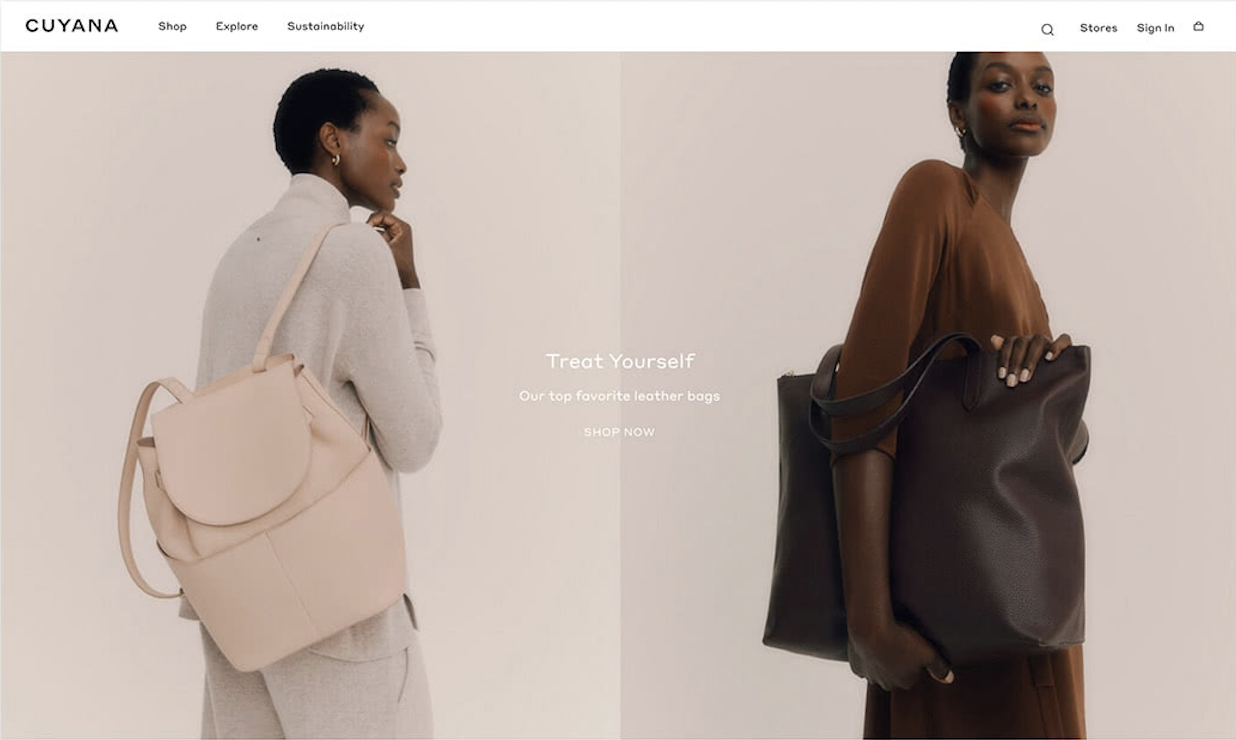
Cuyana e-commerce site homepage
Social media
The role of social media has grown in importance -- whereas brands' social media once served as a place for campaigning, it has become much more multipurpose than simple advertising. What exactly led to the evolution in social media over the past year?
- Lockdowns around the world instigated consumers to spend much more time spent online
- The absence of physical interaction and events opened up a space for virtual replacements
And even prior to 2020, social media was already a platform where consumers, brands, and influencers existed symbiotically. Today, this culture lives on, and changes in consumer behavior have led these platforms to become even more interactive and personalized. Consumers today now demand more transparency, authenticity, and simplicity -- on social media, brands and influencers have had to respond accordingly to adapt to new consumer requirements.

In-app Instagram shopping
So how can fashion brands take their social media to its fullest potential?
The chief answer is: omnichannel streamlining. In layman's terms, ease-of-access. Consumers today need what they're seeking to be a click or two away, and the look and layout of the website itself matters immensely. According to Shopify, 6 out of 10 shoppers admit that the possibility to shop via mobile phone is "an important factor" in deciding from which brands to purchase.
An easy-to-use, visually-appealing e-commerce site that is adapted to mobile phone use can make a world of difference for brands' sell-through.
In the same vein, integrating social media into e-commerce is indispensable today. It's why digitally-native brands exist, and why it works so well. On average, Gen Z consumers spend 4.5 hours per day on social media, and Millennials spend an average of 3.8 hours according to a recent survey from YPulse.
To be digitally native is to be innovative
Because social media usage is now so high, brand-to-consumer relationships have become more intimate. Indeed, digitally-native vertical brands (DNVBs) already had a grasp on this strategy long before the pandemic: DNVBs are born online and employ a DTC approach, fostering customer experience above all else.
On Instagram, brands like Musier, Rouje, and Eliou have mastered the art of Instagram, curating their page like a fashion magazine and involving their followers in collections, posts, and stories. Their fresh, youthful brand identity appeals perfectly to Instagram's largest customer base of Gen Zers and Millennials.

On TikTok, ASOS launched its own challenge, dubbed the #AySauceChallenge, in which users were invited to show off their ASOS outfits while dancing. The retailer partnered with a list of major influencers, and even created a custom audio for the challenge. As of April 2021, the hashtag is in at 2.5 billion views on the app.
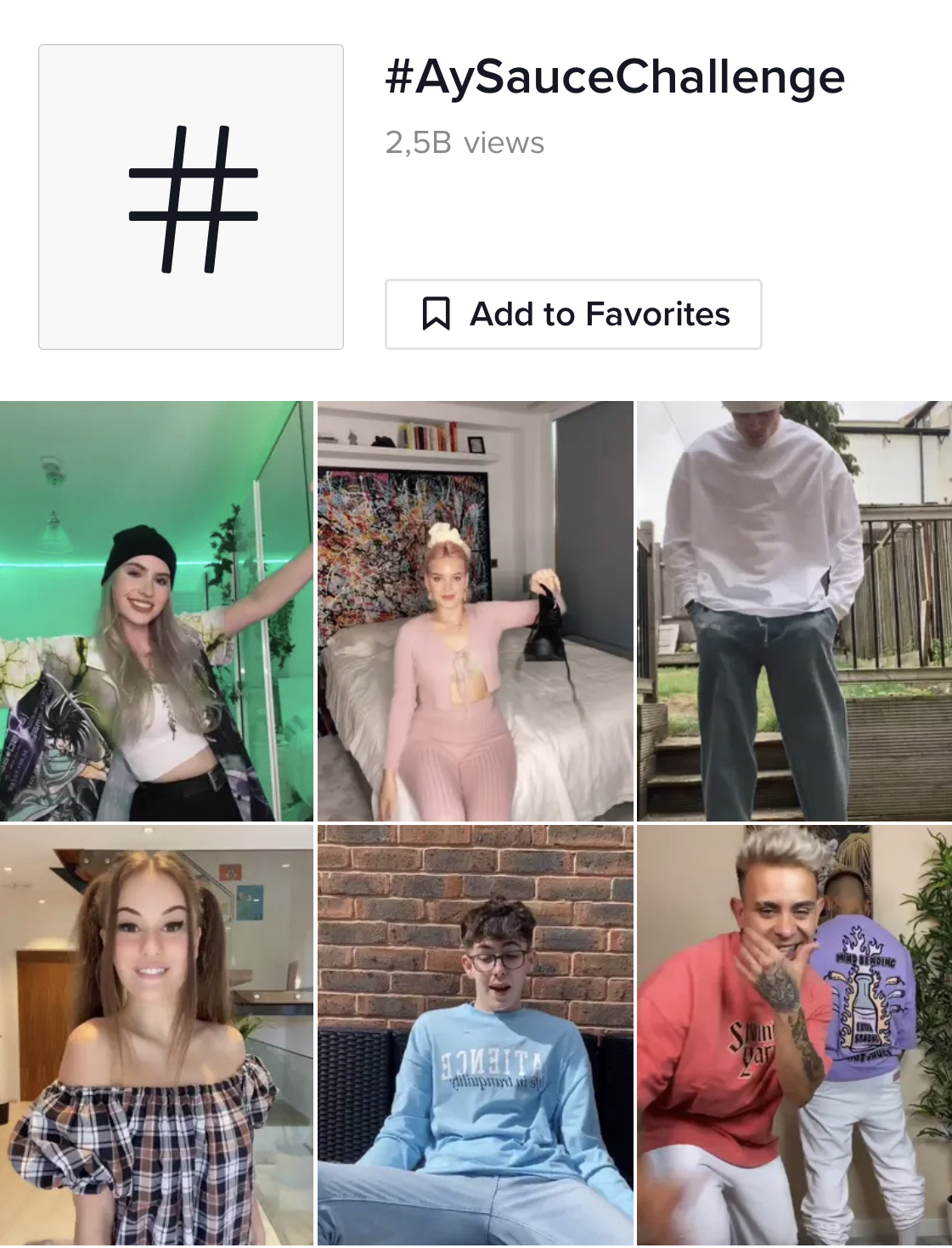
On WeChat, American luxury leather goods label Senreve penetrated the Chinese market purely through social media marketing. The brand spent nearly two years on the platform, combined with a hefty presence on social commerce platform Little Red Book. Today, Senreve's Chinese sales have grown from 20% to 50%.

But these are just a few examples -- these are some more ways that brands can expand their marketing strategy on social media:
- Collaborate with influencers
- Use promotional ads
- Stay in touch with trends like hashtags and challenges
- Capitalize on meme culture and virality
- Create branded AR lenses, filters, stickers, and audios
- Engage in brand takeovers on popular accounts

Social media commerce: A DTC approach
For non-digitally native brands, the pandemic pushed many to become more strategic in their social media approach. Direct-to-sale features have become a main tool for many of these brands on social media: consumers can now shop directly from the Instagram app, for instance.
Indeed, social media is an indispensible arena for reaching consumers. A survey conducted by Search Engine Watch found that 73% of US teenagers say Instagram is the best way to reach them with new fashion items and trends, proving the effectiveness of social media in brands' marketing strategies. In consequence, more than just brands have begun looking to social media to track consumer desires and trend behavior: trend forecasters like Heuritech scan social media images with an AI technology to draw out trend insights.
Marco Marandiz, e-commerce strategist, attests to this approach:
"Websites will become less relevant and social media channels - TikTok, Instagram, Twitter, YouTube - those are going to be far more powerful for driving sales directly to a specifically built site to make a sale."
Influencer marketing
Oftentimes, brands don't act alone when it comes to social media marketing. Influencers are a significant part of this strategy and have a direct impact on consumer buying decisions. According to 2020 research from the SHS Web of Conference:
- More than 55% of respondents consider products that promote influencers to be better than others
- Nearly 30% of respondents would buy a product just because it was promoted by their favorite influencer.
This helps explain why so many brands have upped their influencer marketing over the past 12 months -- it works. And it's not only human influencers -- even the influencers themselves have been digitized in some cases. Noonoouri, a virtual model created by Munich-based designer and creative director Joerg Zuber, has nearly 400K Instagram followers. The digital character already has partnerships with Dior, Versace, Swarovski, among others, advertising brand products to her many followers.
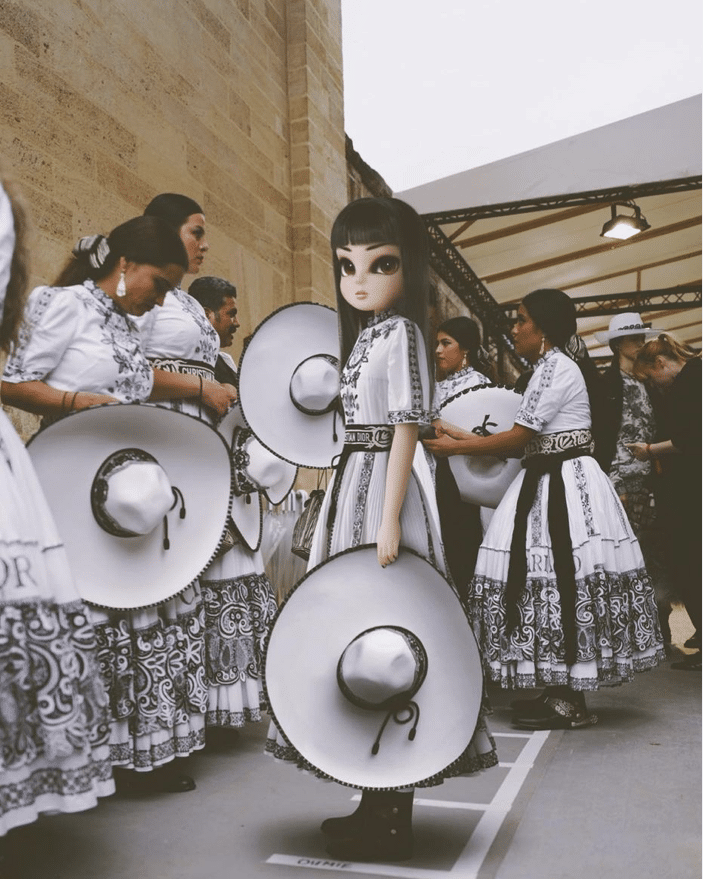
Noonoouri x Dior
All this to say that digital marketing has no limits, and social media allow brands to:
- Grow and even diversify their consumer base
- Be in touch with their consumers' social, cultural, and even political sensibilities
- Optimize multichannel ecommerce through multiple social media platforms
- Strengthen their influencer portfolio with micro, macro, and hero influencers to reach a wider audience
- Create desirable content even outside of the marketing realm
- Increase sell-through and bolster brand awareness
Ultimately, brands must meet their consumers where they are - and where they are, is social media. And while the virtual arena is growing in importance, it's also necessary to optimise traditional shopping: brick-and-mortar stores hold a world of opportunities for digital transformation.
Brick-and-mortar stores
Does digital transformation always have to exist exclusively in the virtual space? Not at all. A growing number of brick-and-mortar stores have taken the leap, integrating digital processes into traditional ones. And given the numbers, more and more brands should consider upgrading their in-store experience to match the online experience. According to WWD, over 50 major fashion retailers "experienced dips in revenue north of the million-dollar mark" in 2020. While global lockdowns and thus store closings largely contributed to these numbers, it's also a sign that consumers are no longer satisfied with the status quo.
Consumers want their reality to match their virtual reality, and personalization has become vital to the customer experience.
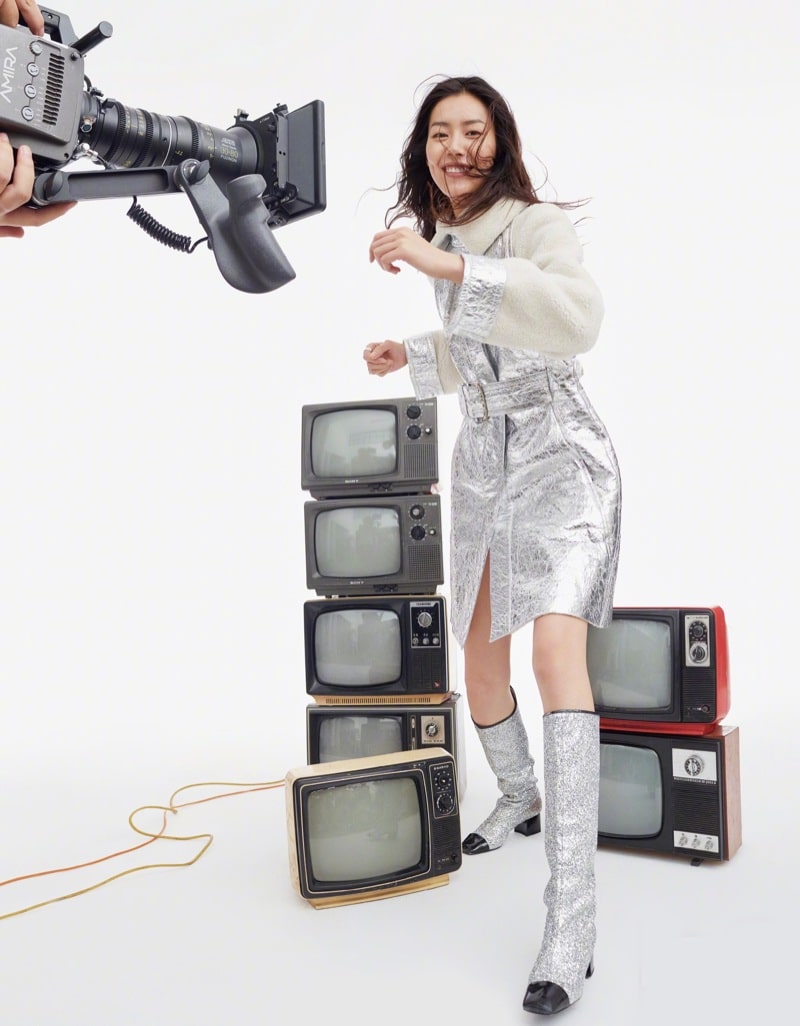
Liu Wen
Creating an omnichannel experience for consumers
One solution is to connect online and in-store shopping. Omnichannel shopping, as discussed at length above, has become the norm for the majority of consumers. A report from Kibo found that a whopping 94% of Millennial and Gen Z consumers do research online before going to a physical store, from checking inventory to store hours.
Shopping in-store should offer the same personalization and information that does online shopping -- the biggest pain point among many consumers when in-store shopping is the lack of choice or efficiency, and for online shopping, it's the lack of human interaction and experience. Combining the two thus requires a digital angle. There exist several solutions:
- Replacing loyalty cards with loyalty apps
- Bring online reviews offline
- Attach QR codes to items for access to pricing, product information, reviews, and more
- Ready-to-order personalization
- Virtual shopping assistants
- VR and AR fitting rooms
Innovative technologies for a futuristic in-store shopping experience
These are just a few of the ways brands can marry online and in-store shopping. If we take it one step further, some brands have embraced digital transformation in even more innovative ways to boost their customers' in-store experience.
1. Virtual assistants: These are now being used in-store by brands and retailers including Nike, Harrods, and Intersport. Why? Well, virtual assistants already exist on many e-commerce websites: chatbots use machine learning and language processing technology, algorithms can make product associations as a consumer shops, and in-store virtual shopping assistants can thus be installed in fitting rooms or in kiosks, and create a liaison between the customer and a real-life staff member. In-store virtual assistants can:
- Request a different size as a consumer demands it
- Verify if a particular garment is in stock
- Connect with real staff members
- Make product recommendations
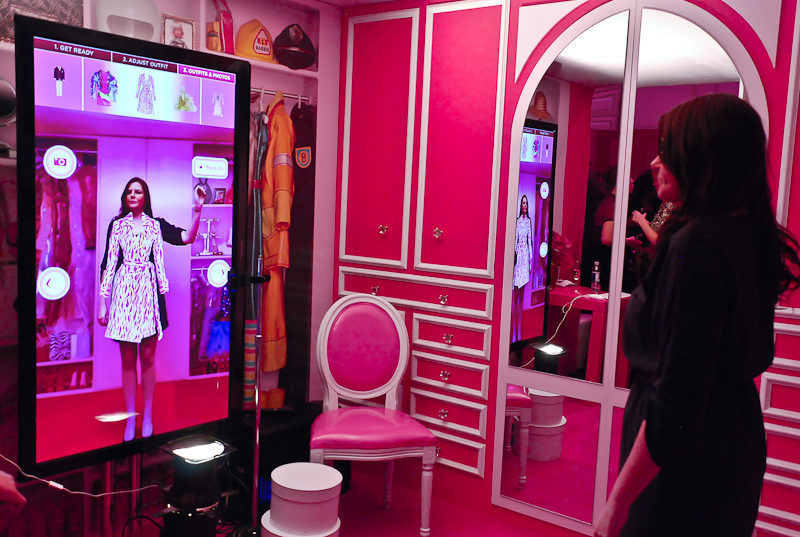
Racked NY
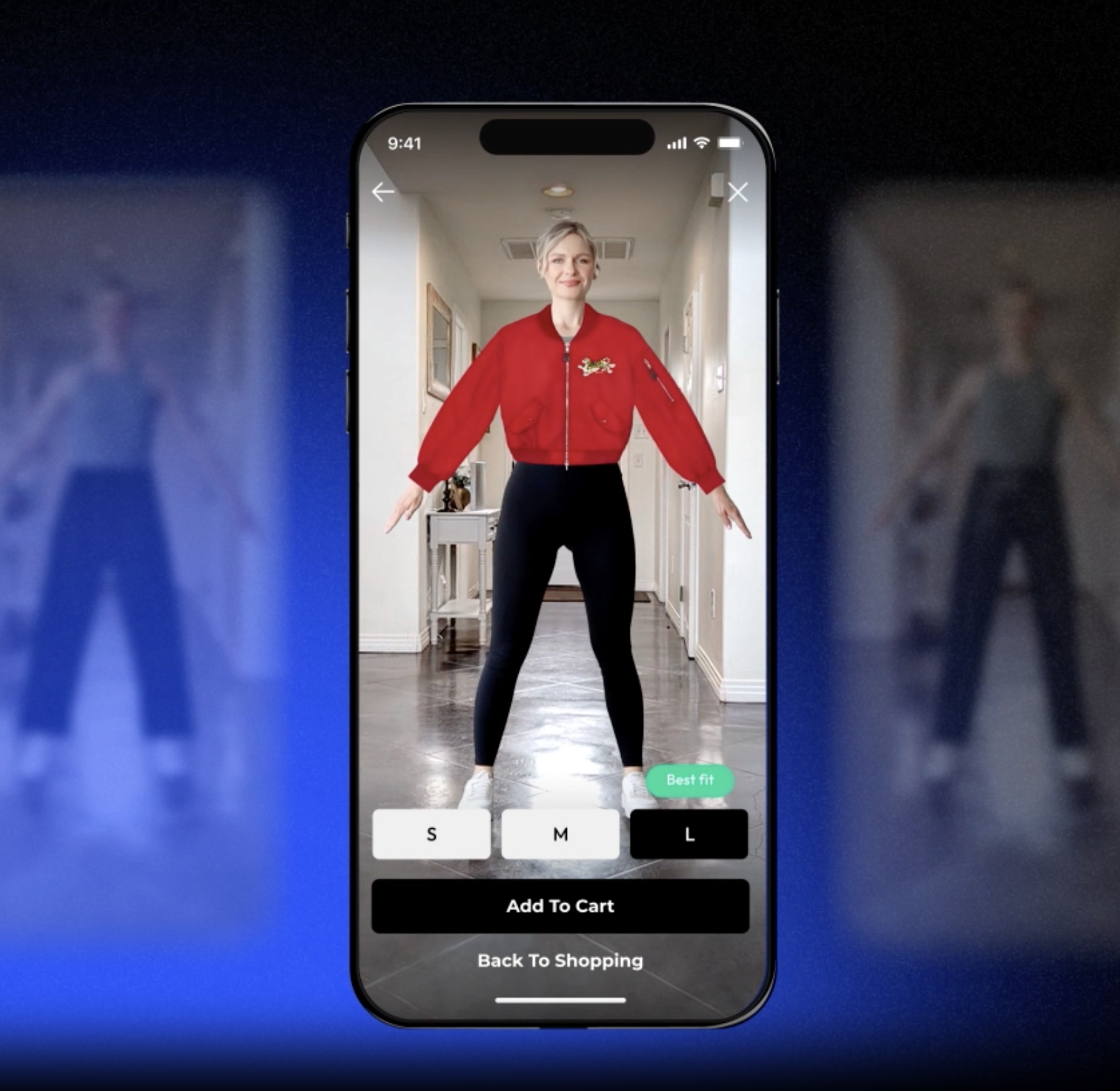
3DLOOK website
2. Digital fitting rooms: These are gaining popularity for brands with brick-and-mortar stores who wish to engage in digital transformation. Some of these brands include Macy's, Adidas, and Modcloth, who have integrated virtual fitting rooms into their physical stores. Learn more about virtual fitting rooms on 3DLOOK website.
Smart fitting rooms typically function with the help of RFID tags that are incorporated into each garment:
- Mirror recognizes the garments thanks to the RFID tags
- Search for other colors, sizes, or associated garments
- Access the store's catalog
- Add items directly to one's cart
- Customers can try on clothing digitally
But to adopt these digital tools - from social media, to e-commerce, to physical stores - it's important for a brand to be on board with this transformation. Aligning or even creating new teams, as well as embracing innovation, is the foundation to a successful digital transformation.
Organizational transformation
The value chain
The value chain is a process in which a company adds value to the products. This is not to be confused with the the supply chain, which is a part of the whole. Indeed, the value chain makes up all the steps along the life cycle of a product:
- Design
- Production
- Marketing
- Distribution
It's important to understand what goes on behind-the-scenes to understand the scale of digital transformation beyond what's visible on the value chain, like e-commerce, for instance.
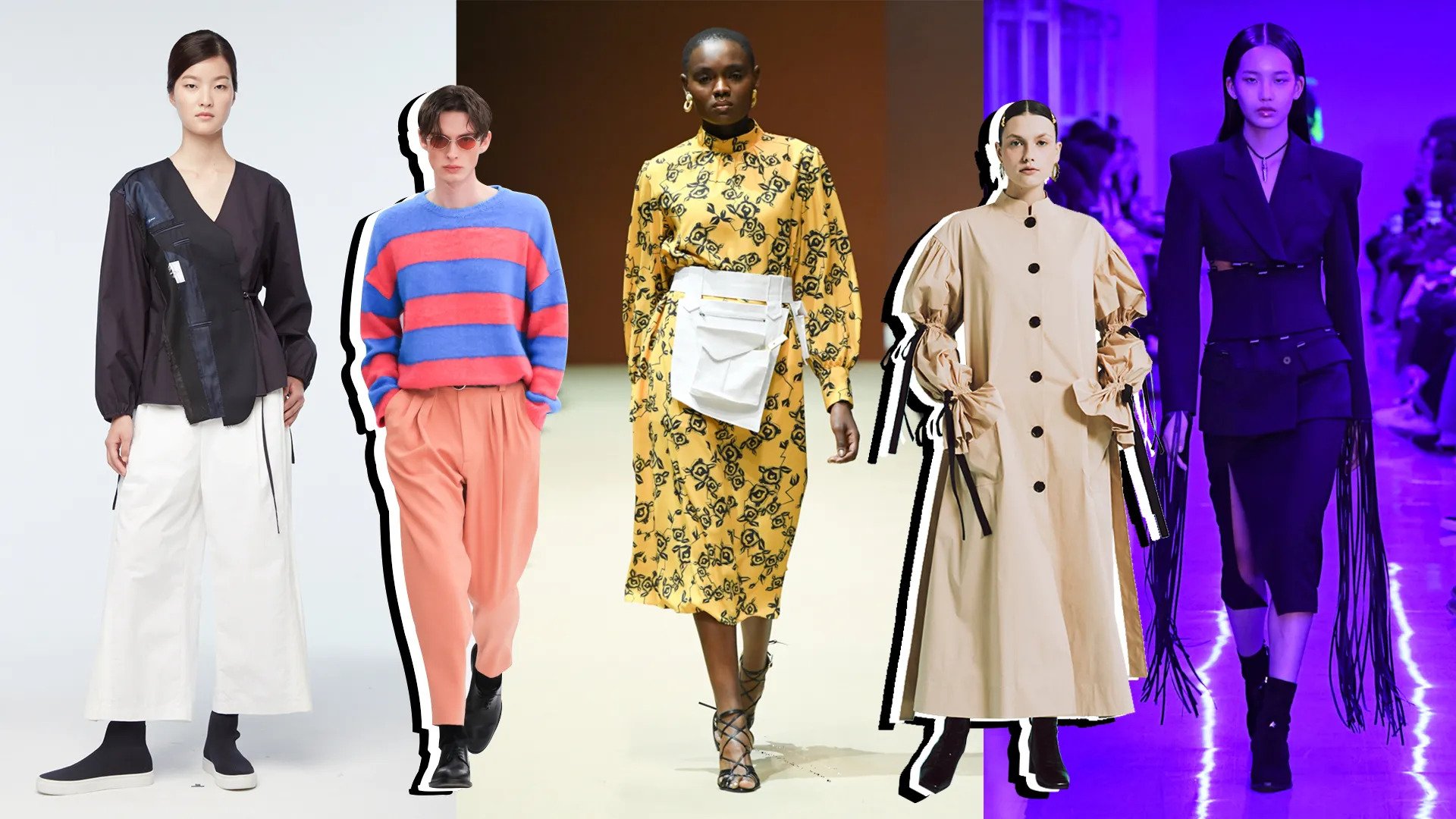
Seoul Fashion Week, courtesy of Vogue
Design in the fashion value chain
This is one of the first steps in the value chain. Today, virtual design tools help bolster existing design processes to render them more:
- Streamlined
- Time-saving
- Resource-conservative
Tools like design software, 3D modeling, and augmented reality are revolutionizing design for a growing number of brands.
1. Augmented Reality: This technology superimposes a computer-generated image on a user's view of the real world. Its benefits for design are many:
- Measure the exact resources required to cut down on fabric and other waste
- Customers can create customized clothing in their desired designs
- Digitally take customer measurements
- Cuts down on time and renders clothing more size-inclusive
- Customers can do remote fittings with an avatar of themselves
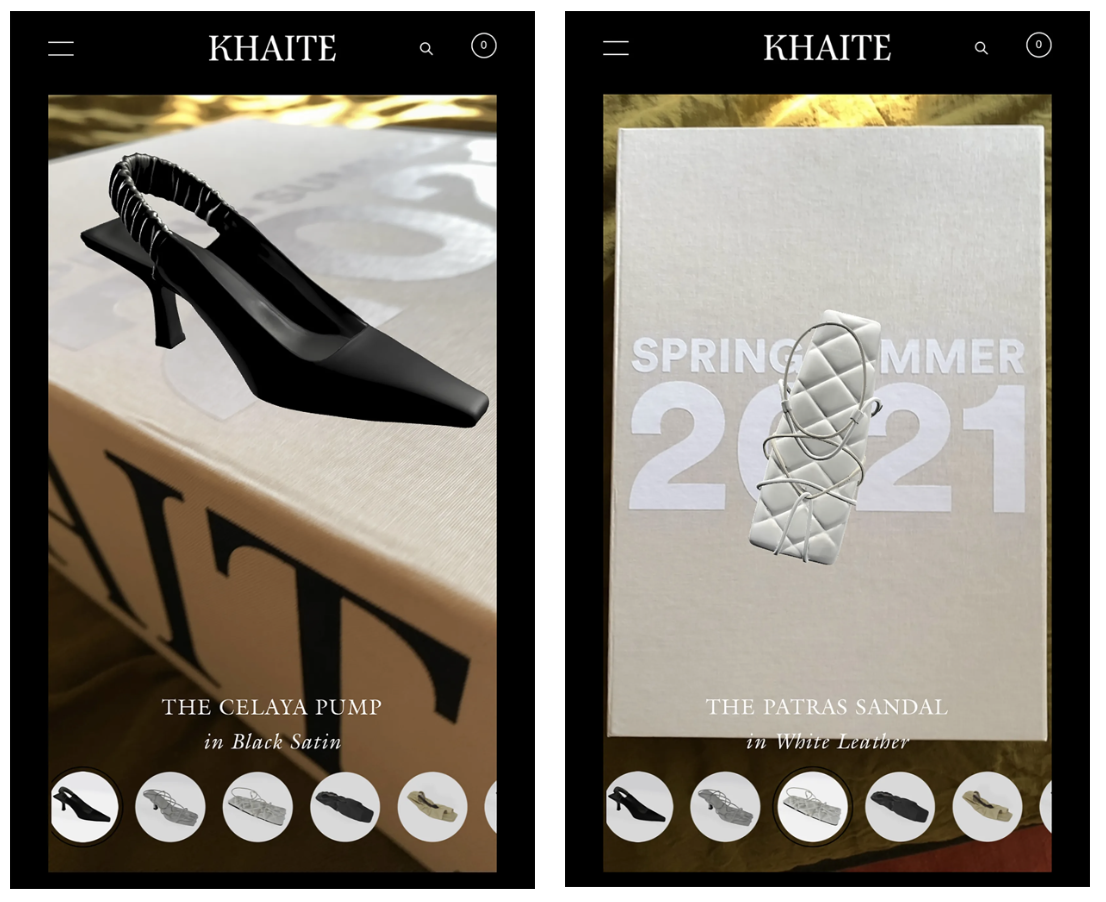
Khaite Spring '21 AR collection
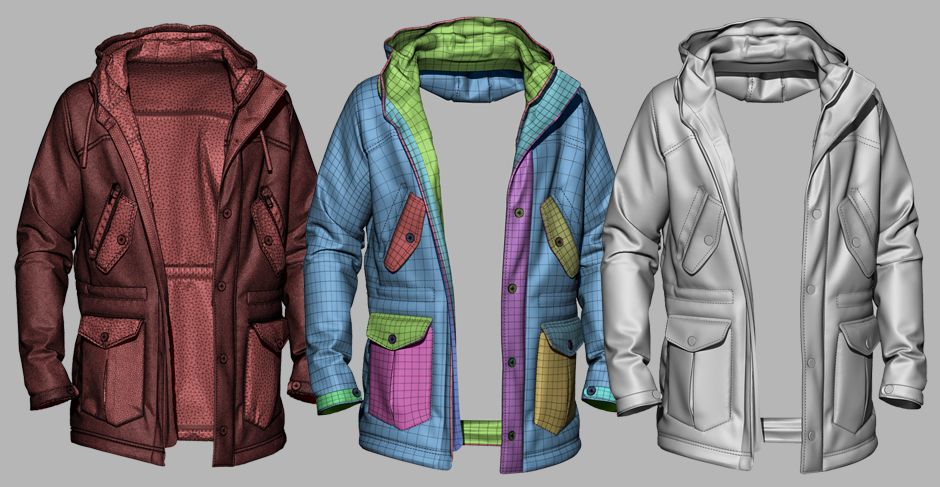
Live Training Lab
2. 3D Modeling: This is a technique in computer graphics for producing a 3D digital representation of any object or surface. Its benefits for design are many:
- Create custom designs and prints
- The designs and parameters can be sent directly to the manufacturing site to be constructed there
- Designs can be changed at any stage of planning without wasting physical resources
- Importing specs allows designers to see how fabrics move in motion
- Some examples include Browzwear and Optitex.
3. CAD Software: Computer Assisted Design software allows designers to create 2D and 3D sketches, digitally. This is useful for data synchronization on the value chain, with successful platforms like AutoDesk or Eva Engines, the latter of which transforms sketches into 2D product images for designers.
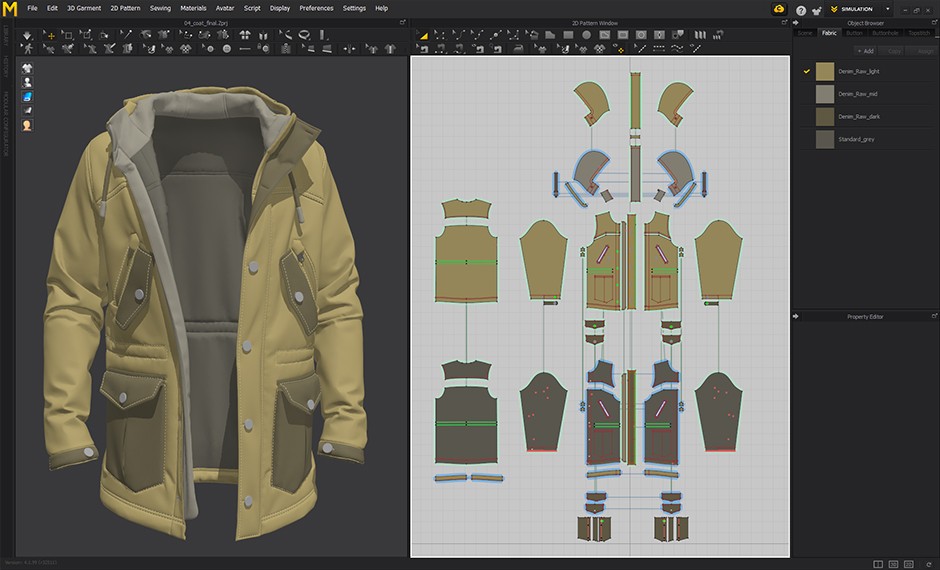
Clo3D
Production in the fashion value chain
This follows the design stage and involves a series of steps:
- Product development
- Production management
- Materials production
- Assembly
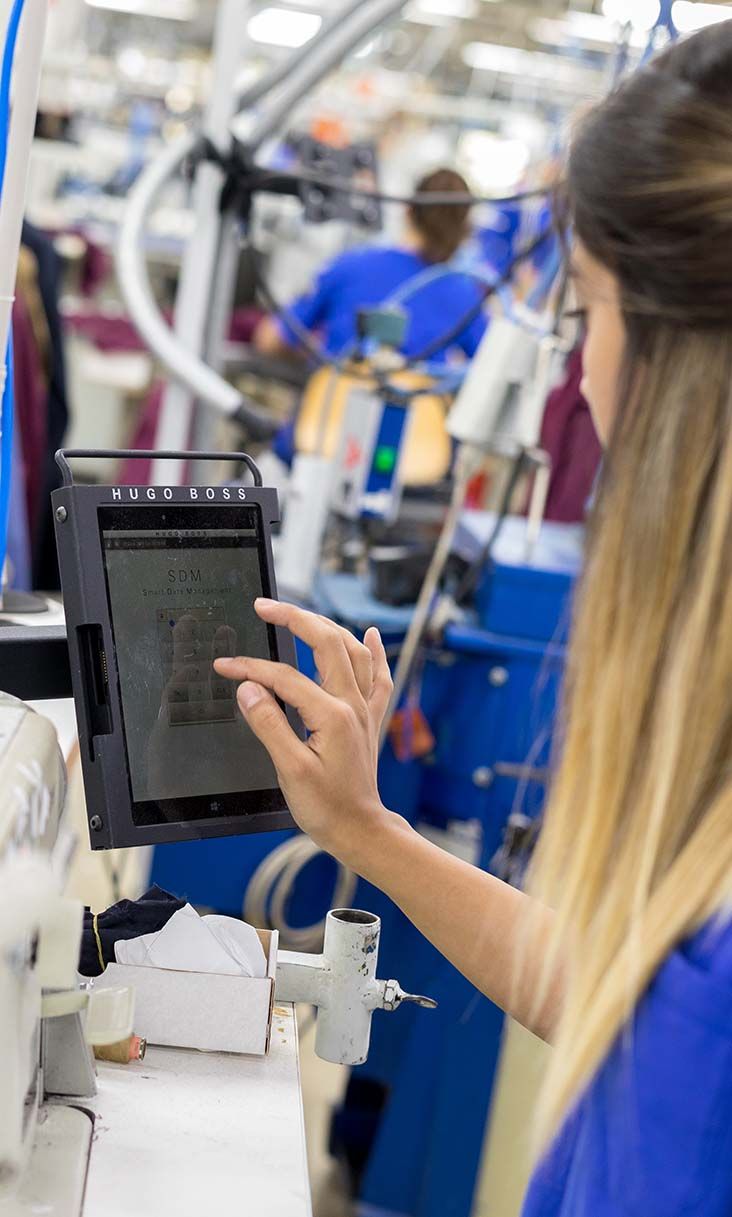
Clo3D
1. Smart factories: A smart factory uses at least one Industry 4.0 technology, including robotics, AI, analytics, or IoT. Smart factories increase efficiency across the board by:
- Lowering the need for human
- intervention
- Shortening time-to-market speed
- Reducing raw material waste
- Decreasing production costs
- over time
Hugo Boss is one brand that uses smart factories in their production. For Hugo Boss, the ultimate goal of the smart factory is to build a sort of digital twin of the traditional factory that can replicate everything the other does. This approach drastically reduces the margin of error during production.
There's more to the value chain beyond e-commerce, design, and production, but the message is this: there exist digital solutions for any challenge along this complex process.
Digital tools for the fashion supply chain
The fashion supply chain is the back end of product production. 60 million people are employed by the supply chain globally. This process involves:
- Sourcing of raw materials
- Factories where raw materials are transformed into products
- Distribution network by which the products are delivered to consumers
The supply chain is a famously complex process, and often contains the most moving parts for any fashion brand, but also the most room for change.
Research from The Economist's Intelligence Unit and Maersk finds four main challenges for fashion brands in the supply chain:
- Fluctuations in customer demands
- Lack of flexibility
- Customer expectations
- Opacity

These challenges can often be related back to planning -- a lack of proper data and analytics lends itself to trouble addressing demand, logistics, and trends. And as the industry grows more and more interconnected with globalization, the multitude of data sources grows more complex. Brands must adjust their methods along the supply chain. Why?
- Access to more innovative technologies
- Increased consumption in general
- Consumers are also demanding more transparency in the supply chain
- Sustainability is more pressing than ever
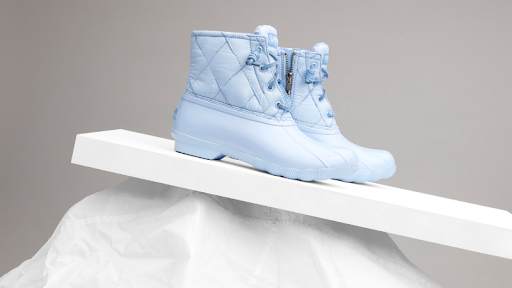
Wolverine
1. Predictive analytics: This is the process of employing statistical algorithms and machine learning techniques to use the past to make predictions on the future. It is one of the top combatters of disorganized processes and guesswork in the supply chain.
Heuritech is one company which offers data-backed trend forecasting to provide insights on future market demand. With Heuritech, footwear company Wolverine reached a 100% sell-through on a pair of boots using trend forecasting, for example. Evidently, predictive analytics can help reduce wasting time and resources, and limit uncertainty.
Listen to a Wolverine executive chat about trend forecasting:
2. Blockchain technology: This is a type of database which records and tracks events in a product's life cycle. Blockchain helps resolve issues along the supply chain including:
- Unclear sourcing
- Untracked products postproduction
- Unknown manufacturing locations
- Authenticity of products
- Damaged or resold products
- Consumer demands for transparency
Arianee is one company that uses blockchain technology to do exactly this: brands and consumers can track their products from start to finish. This way, manufacturing is streamlined and consumers remain in the know.
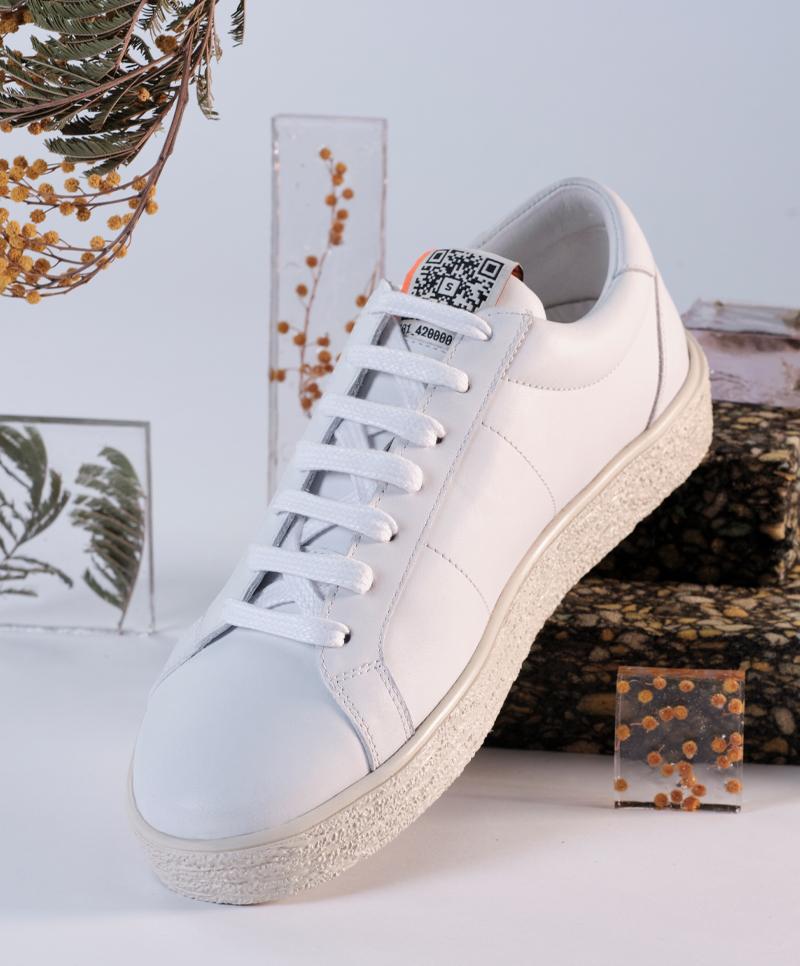
Satoshi Studio
Challenges such as these are why proper data sources are essential to the supply chain today. Data analytics help:
- Render the supply chain efficient and adaptable to evolving obstacles
- Make decision-making more resolute and strategic
Indeed, the combination of proper strategy, technology, and willingness is all that's needed to enact this true transformation. In the words of Maersk's March 2021 Report on digital transformation:
"If we are to forge systemic change, a broader program of collaboration is needed, where different parties work together- and technology is simply the enabler to make this happen."
Aligning and transforming teams
The advantages of digital transformation are clear, ranging from social media to the supply chain. What can be tricky, though, is implementing digital transformation throughout the teams within a fashion company, who tend to think and function differently from one another. Indeed, DT isn't reserved for tech or data teams -- to reap the benefits, teams must:
- Evolve their jobs to work using digital solutions to their highest potential
- Align with one another via these digital solutions
Let's dive into two examples of digital transformation to understand the associated shifts and benefits for teams.
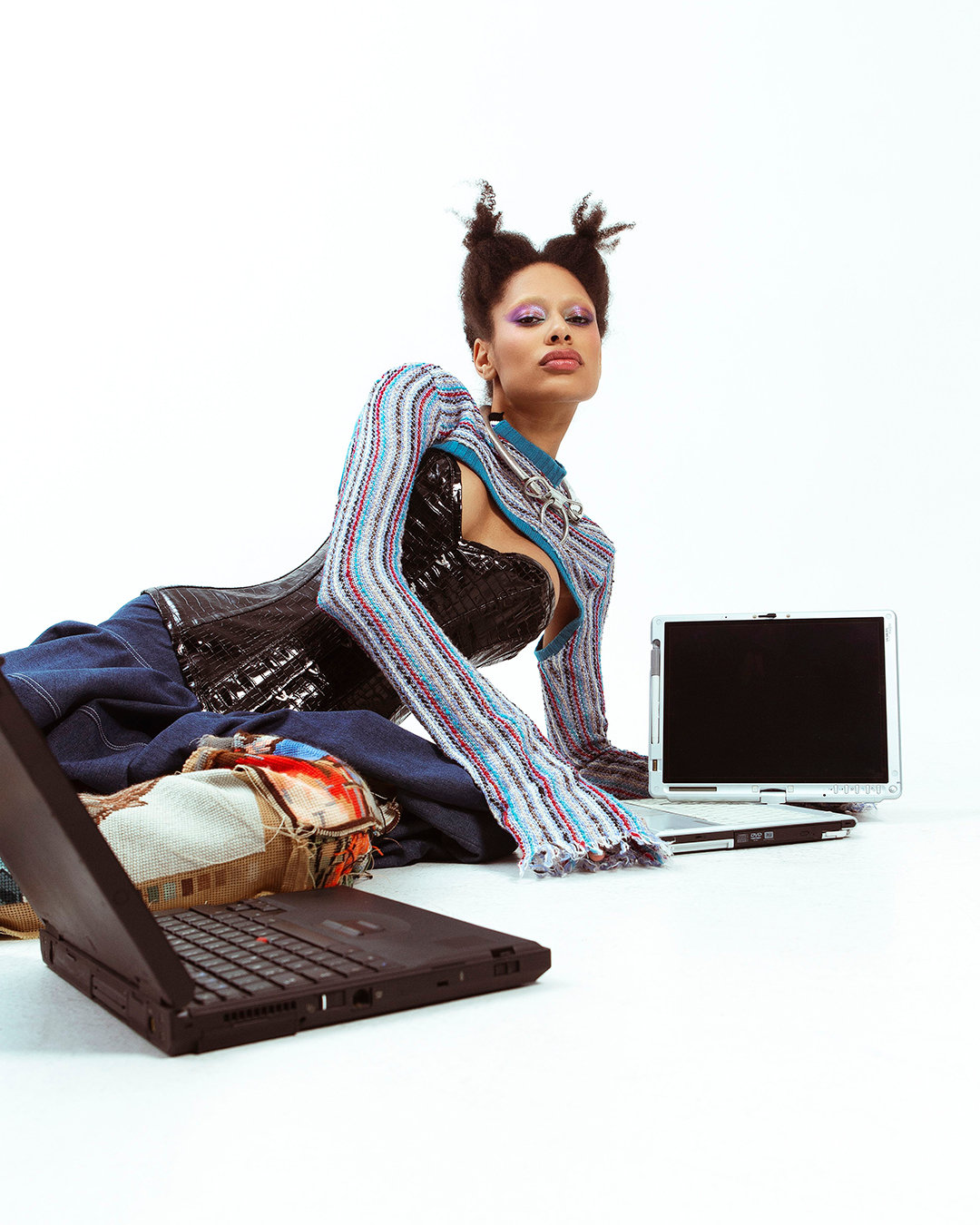
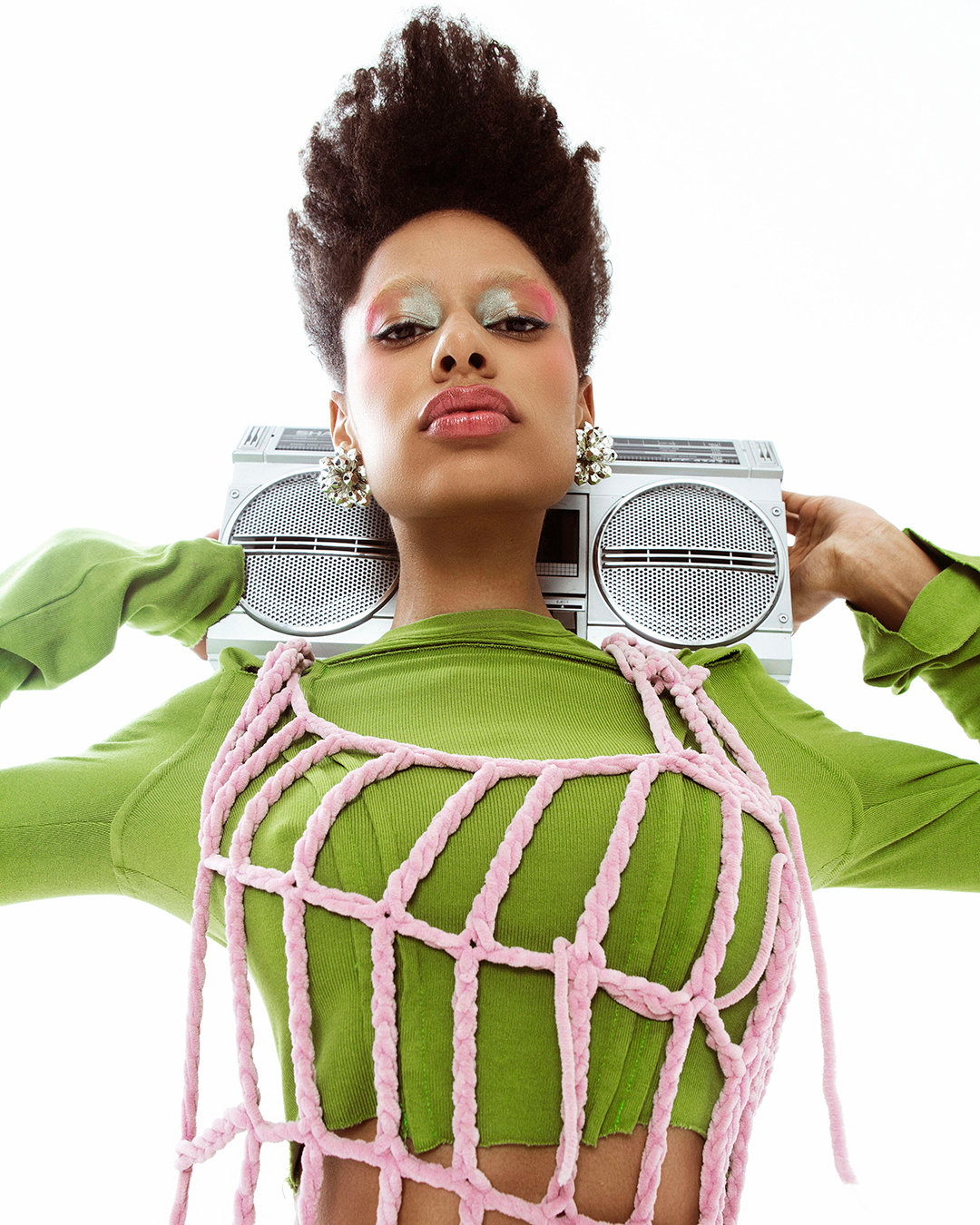
Cyber Ivy for Pap Magazine
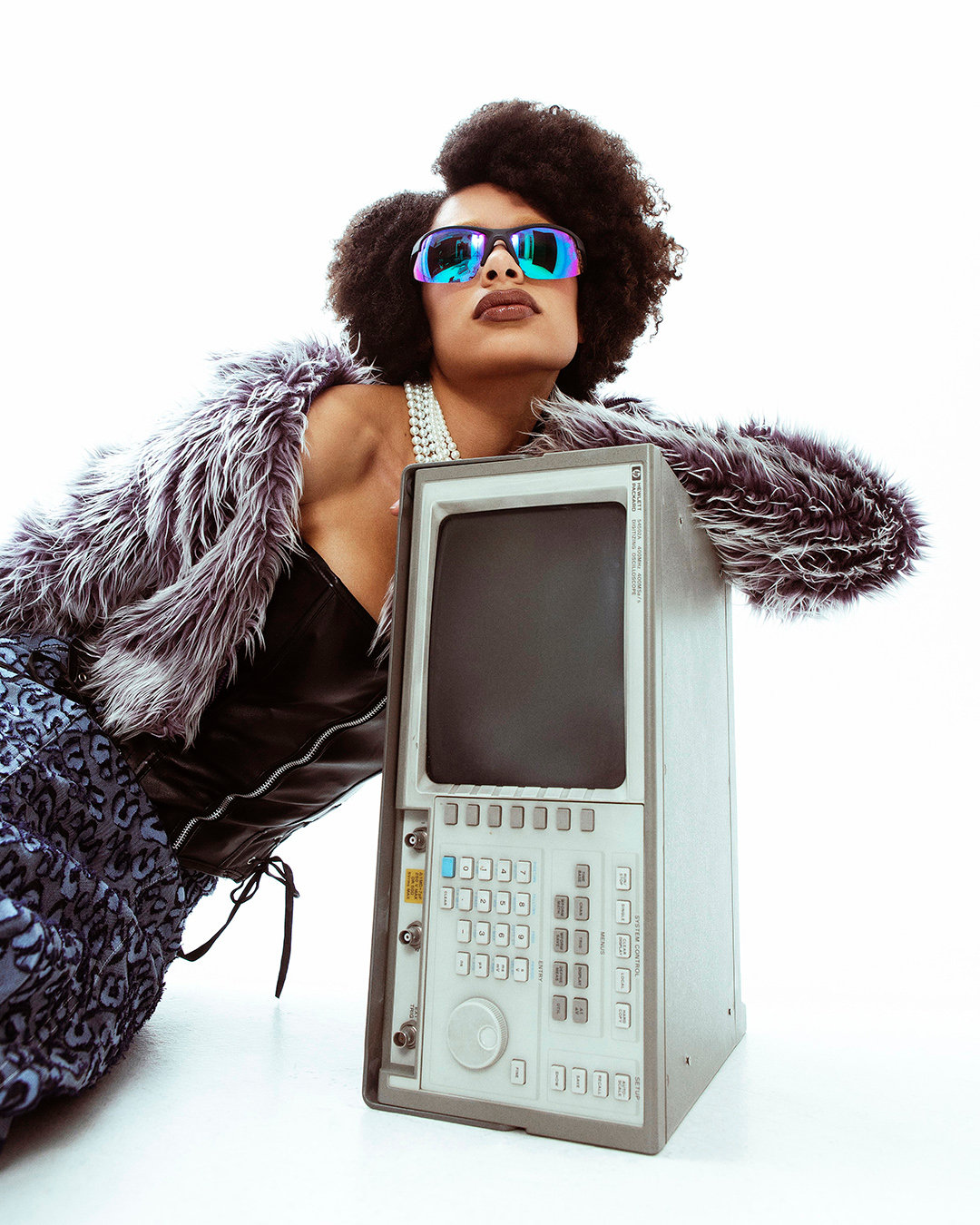
Blockchain to align teams
Blockchain is one example of digital transformation in the industry that's initiated quite some buzz. The blockchain feels like a natural consequence of the modern consumers' values of sustainability and accountability from their favorite brands. The blockchain can track:
- Sourcing
- Manufacturing
- Change in ownership
- Damage
Transparency is great for the consumer, but also for the brand itself. The blockchain has a host of benefits for both parties, but there must be a change in mentality and organization.
Integrating blockchain technology into one's value and supply chain requires a reworking of a brand's existing business model both in back-end and front-end.
What's an example of how blockchain technology can be integrated by different teams to create a collection?
1. Suppliers and manufacturers: They are accustomed to the traditional supply chain system:
- Data often lives in silos
- Organization is centralized
- Manufacturers don't always know where suppliers source their raw materials
- Suppliers don't always know the destination of the finished product
With the blockchain, though, raw materials and finished goods can be tracked from their source, to the factory, to the final product, and through the distribution network. With proper data thanks to the blockchain, buying and merchandising teams can:
- Adjust planning,
- Adapt stock,
- And modify drop times for different store locations and markets
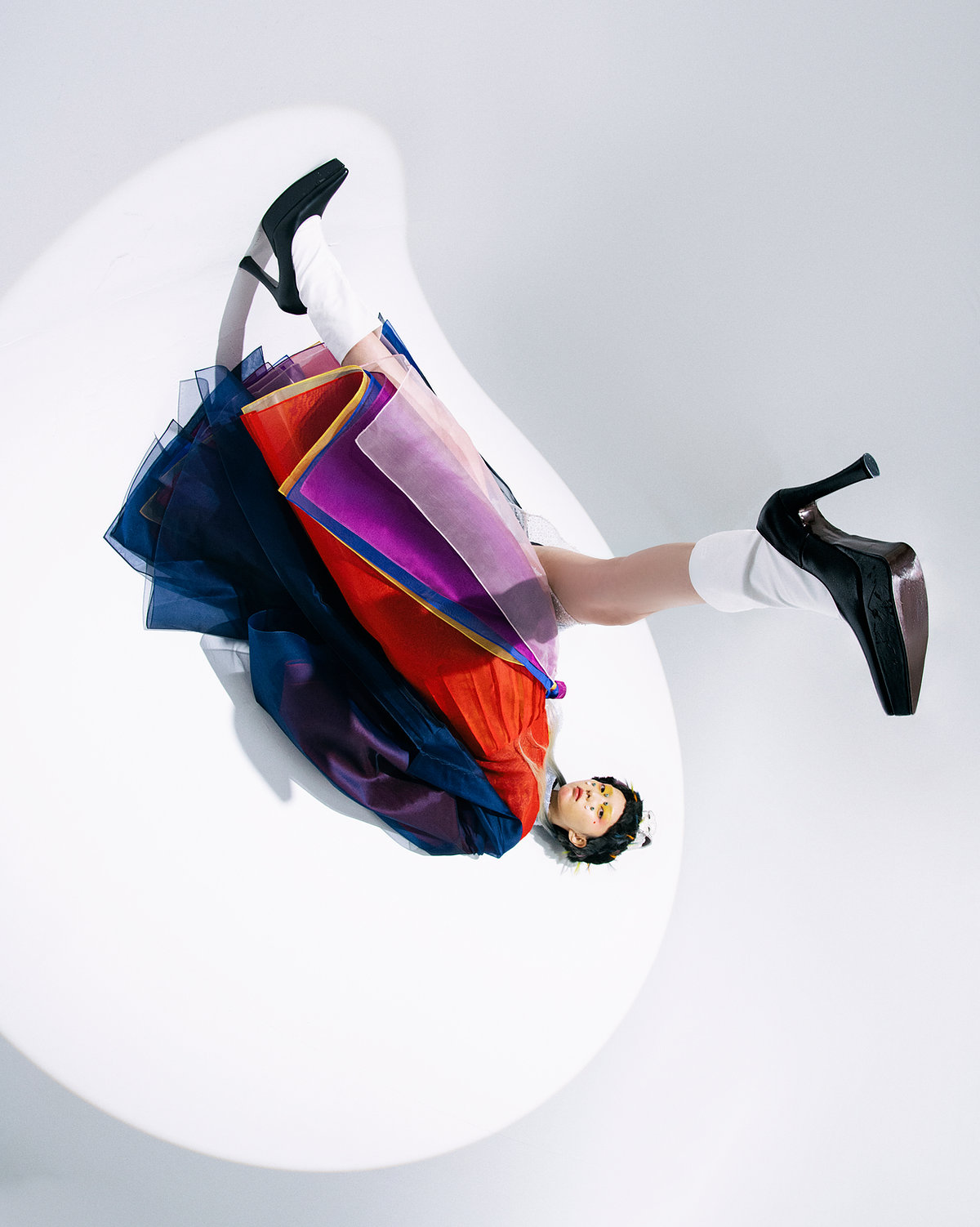
Unpredictable Harmony for Pap Magazine
Blockchain-powered supply and value chains are a true digital transformation for a fashion brand, and with this approach, teams can work together to create improved forms of production and creation. Blockchain technology leads to:
- Unilateral data synchronization
- Greater efficiency along the supply chain
- Improved communication between suppliers and manufacturers
- Reduced time-to-market
These insights bring the concerned teams together by avoiding unsynchronized or even unsimilar data sources. There exist many more ways that the blockchain can better align teams within a fashion brand, but for brevity's sake, this technology leads to a more synchronized, streamlined, and sustainable supply chain. Blockchain is one solution, but it must be adopted in its own way to effectively align teams. Let's have a look at how trend forecasting has a different impact and integration on teams.
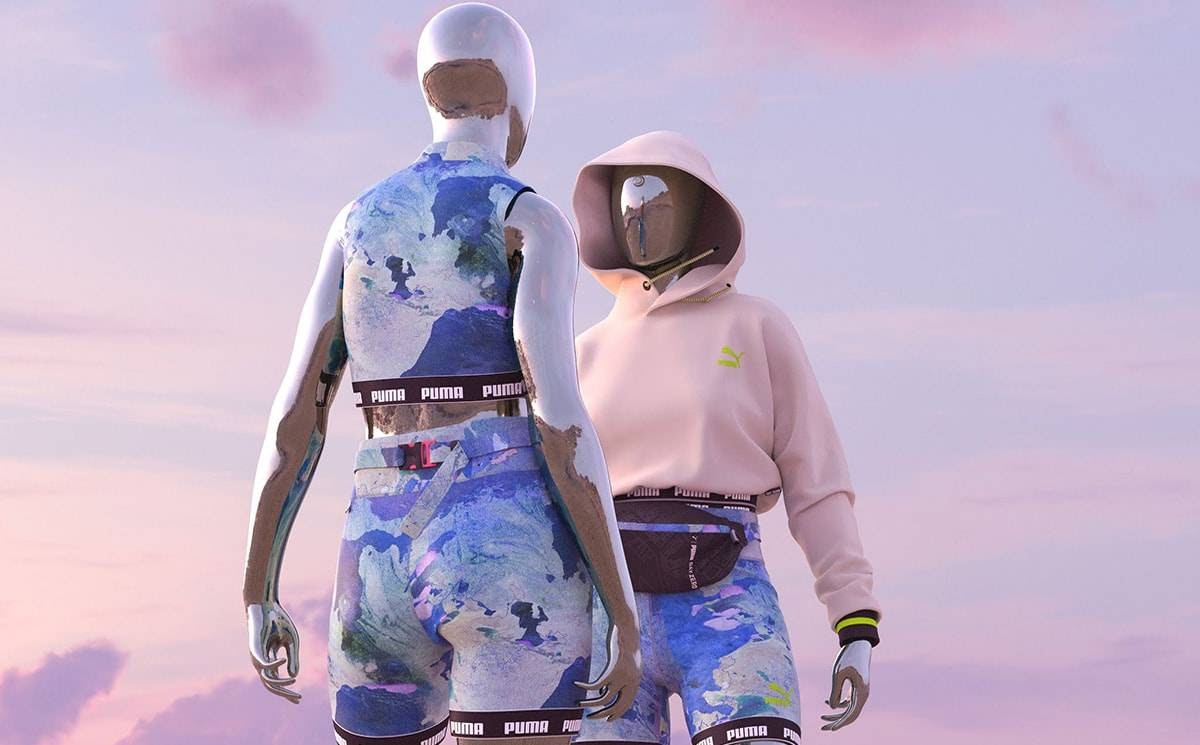
Puma x Central Saint Martins
Trend forecasting to align teams
Trend forecasting is another form of digital transformation that can align teams at a fashion brand. Let's look at how and why implementing data-based trend forecasting, or predictive analytics, in the collection planning process is a cross-team effort which benefits designers, merchandisers, and marketers.
This technology is a genuine digital transformation, as it bolsters existing processes in collection creation to render the whole more streamlined. Looking into teams within a fashion brand, how does each team benefit from trend forecasting, a digital transformation in its own right?
1. Design teams: This team is the first bastion of collection creation. Some of the ways designers evaluate the market are through:
- Competitor's recent collections
- Brand archives
- Popular culture
- Social media
Designers make decisions about what to create based on external sources but also personal affinities, so the idea of introducing a new technology can seem like a surplus. But digital solutions are becoming increasingly vital to the design process, from 3D-rendered designs to data-based trend forecasting.
With predictive analytics on trends and their behaviors, designers can:
- Get inspiration
- Back their existing intuitions
- Gain new insights on the market and get a clue on emerging trends
- Prepare collection meetings through key qualitative and quantitative insights about the relevance of trends
- Obtain a vision of trends in different markets and among different consumers
- Communicate and explain their trend and product choices to any analytical-minded teams
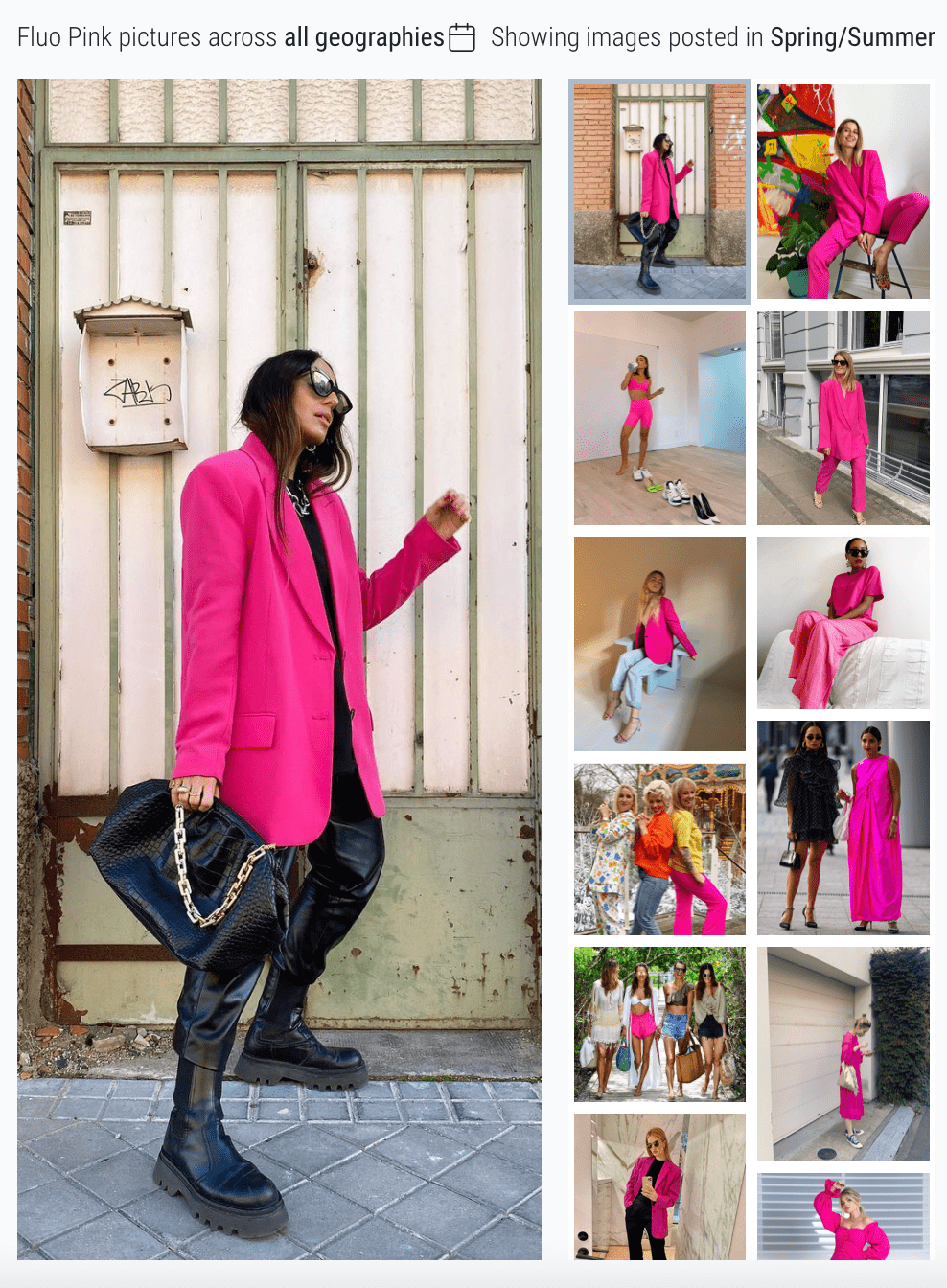
Heuritech trend forecasting platform: Moodboard
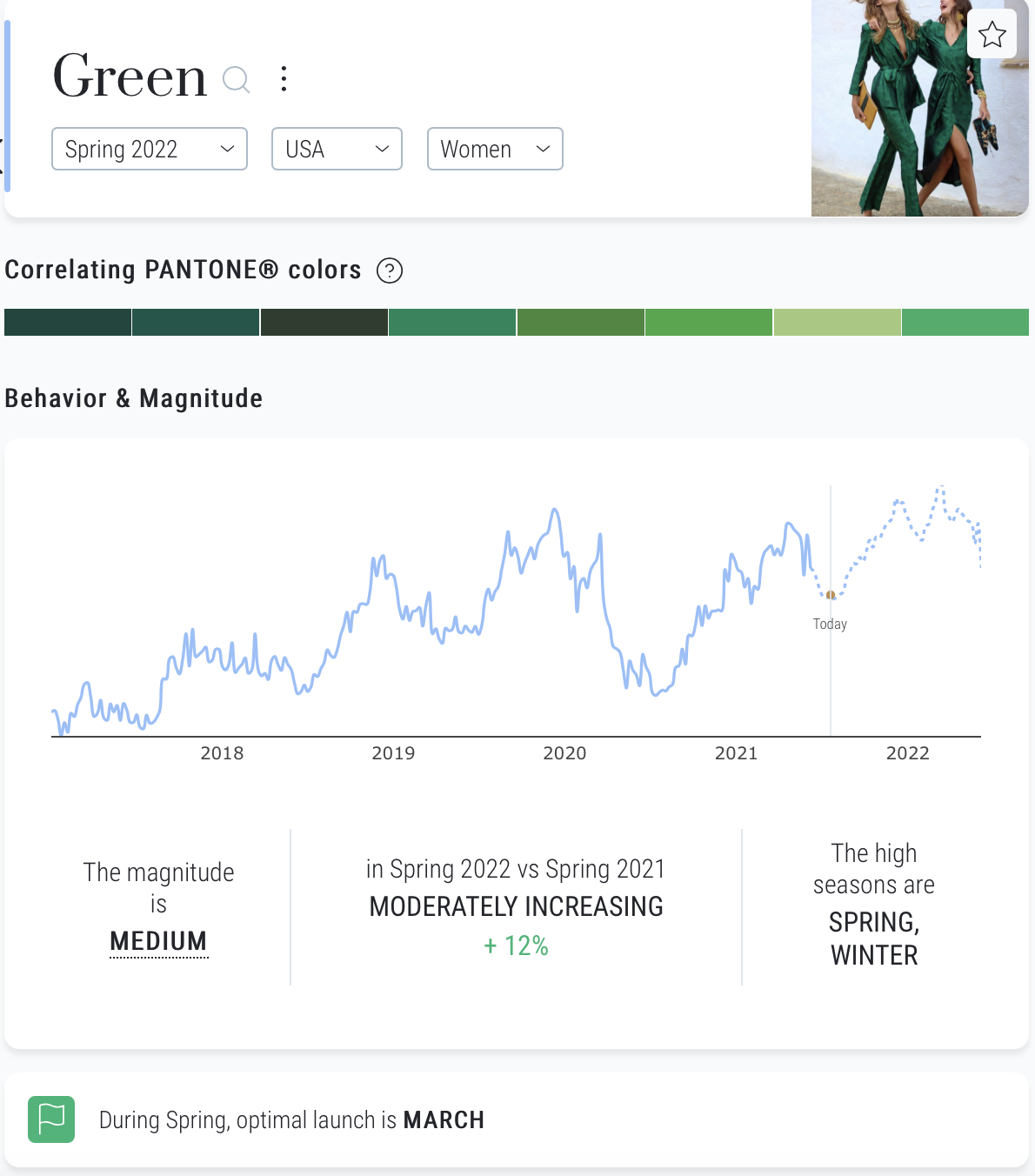
Heuritech trend forecasting platform: Trend evolution
2. Merchandising teams: Like designers, merchandisers constantly scan the state of the market, paying attention to consumers, trends, and any associated developments. The main purpose of merchandising teams is to manage collection assortment, with responsibilities including:
- Products featured in-store and online
- Pricing
- Launch times
- Collection assortment balance
Merchandisers are vital to collection creation, and they are accustomed to drawing from a multitude of data sources to inform their decisions -- these teams are bilingual. They are both analytically minded and sensitive to trends and products on the market.
Where can data-backed trend forecasting improve merchandisers' impact?
- Back intuition with data to reduce uncertainty on product decisions
- Avoid missing future hot trends and sidestep declining ones
- Adjust and balance collection plans and drops in regards to the market's future demand
- Visualize how trends are adopted by fashion-forward consumers
3. Marketing teams: This team is one of the final steps of the collection planning process. They are responsible for all things communication, including creating campaigns targeted specifically for:
- Consumer types
- Geographies and/or markets
- Seasons
In general, information is often spread across multiple channels, and even quantitative data tends to venture into social listening. But with data-based trend forecasting, marketers have access to the market through an analytical, quantitative lens that offers real-time insights, which is essential to connecting with one's audience.
Predictive analytics for trends allows marketers to:
- Anticipate and adjust marketing/communication plans based on market demand predictions to push the right product at the right time
- Identify the key trends within their collection to highlight
- Be more reactive to new trends
- Know which consumer segments to target
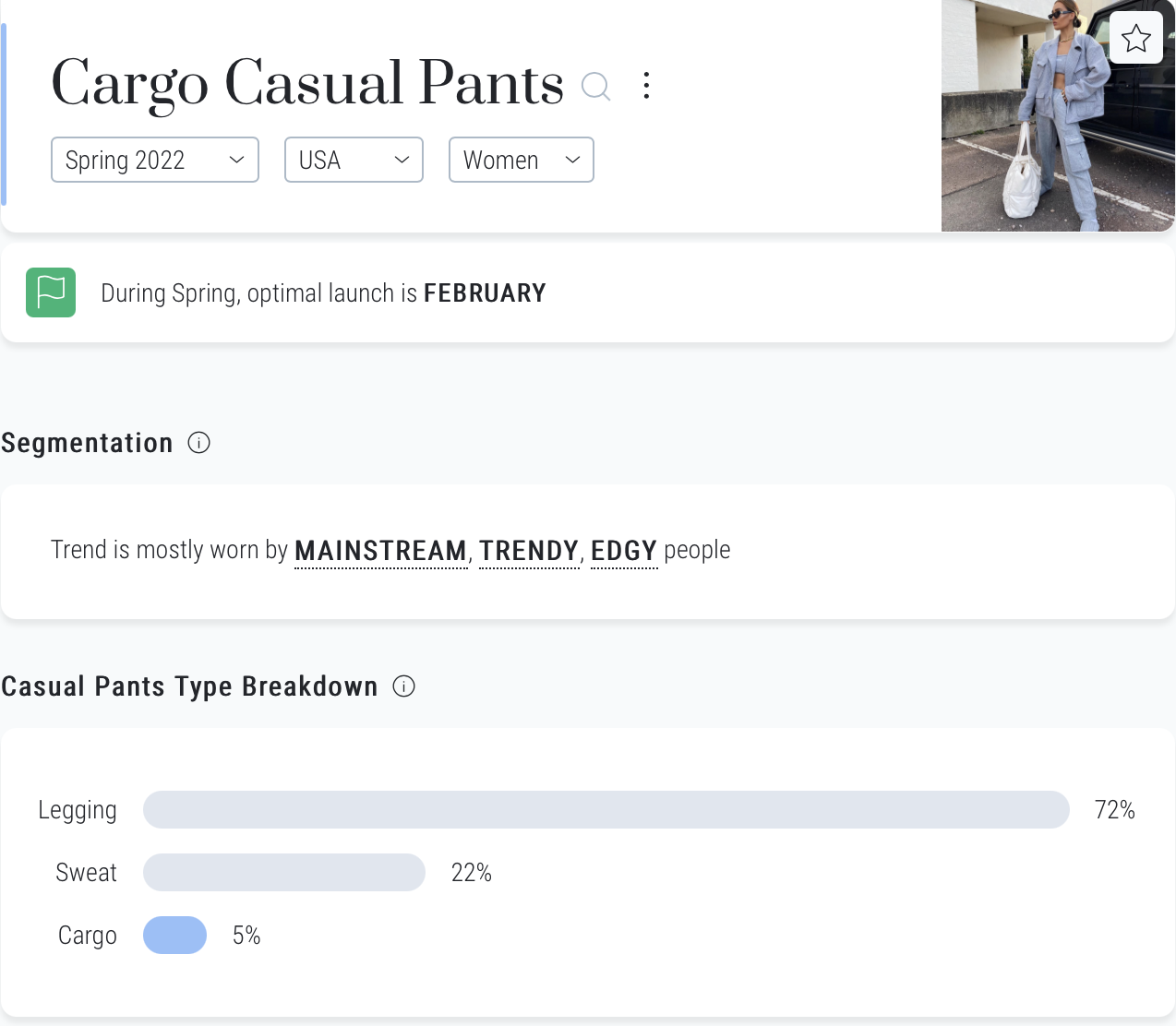
Heuritech trend forecasting platform: Consumer segmentation
For a real-life example of trend forecasting, check out our latest reports by our fashion and data experts. They have tracked the development of pivotal trends on both the runways and social media to better comprehend how to leverage fashion week trends and their life cycle.
Data-based trend forecasting is a team change, a company change, and a mindset change. So how this DT does it align these teams?
- It allows designers to present trends to merchandisers that are backed with data rather than only with intuition
- It gives merchandisers and marketers a quantitative reason for collection decisions
- It provides marketers with the same insights required by merchandisers for more impactful communication and in-store and e-commerce targeting
- It allows designers, merchandisers, and marketers to speak a common language by catering to differing mindsets of each
Digital transformation is as much about accepting improvement with open arms as it is about adopting the tools themselves. Now, the next evolution in digital transformation is more abstract: changing industry and consumer values are finally being properly addressed with digital solutions.
Changing values
Sustainability
E-commerce, design, production -- all of these are unskippable parts of the value chain and of the fashion industry, where digital transformation has and will continue to push it forward. But digital transformation has also allowed for other changes that fashion has long needed.
Digital transformation is helping to make a reality out of what many consumers have been asking for for a long time: sustainability and representation.
Through digital solutions, the industry is slowly becoming more eco-responsable, diverse, and inclusive. As it stands, the fashion industry is the second-most environmentally-harmful industry:
- 10% of total carbon emissions
- #2 in line for the world's largest consumer of water supply


Transplanting by Pap Magazine

These are cold facts that many of us are very familiar with -- more often than not, fashion isn't always so good for the environment. Today, the many facets of digital transformation can present real solutions to fashion's sustainability problem, and it's gaining attention. According to a survey conducted by Nosto in the US and the UK: 52% of consumers want the fashion industry to be more sustainable. The sustainable fashion movement has gained significant traction in the past two years alone. The pandemic is a clear contributor, making obvious many of fashion's shortcomings, including:
- Unethical sourcing
- Lack of transparency
- Overproduction
- Water, air, & land pollution
- Worker exploitation
But finally, the industry is adopting digital solutions with open arms to address fashion's sustainability faults with evolving movements: resell, sustainable raw materials, and virtual fashion.

Jessie Cundiff
Resell is a new sustainable solution
A major movement in sustainability over the past few years is resell, a major byproduct of e-commerce and the pandemic. As a green initiative, resell requires significant digital transformation within fashion companies who wish to go in this direction.
Resell often involves:
- New or transformed internal management
- A new section of the brand's site or third party
- Customer data
- Smart technologies
Platforms like The Real Real and Vestiaire Collective are creating a new paradigm for fashion and luxury resell: their business model is called 'collaborative consumption'. According to ELLE Education:
The collaborative consumption model is comprised of ''trading, renting, gifting, sharing, bartering, lending and swapping goods or services using digital mediums such as apps or platforms.''
Launching one's brand into the secondhand space can require:
- A reworking of one's online presence and platform
- Technologies which guarantee transparency of the products for consumers
- Data on existing or unsold inventory
- Digitalized processes to refurbish damaged items before resell
These technologies are often linked with luxury, and with a brand itself. On the more consumer-centric, fashion-focused side of resell, many Gen Zers and Millennials are getting involved as a part of their general drive for sustainability in fashion. Rather than purchasing new clothing, a growing number of consumers are buying second-hand in an effort to counteract fast fashion and its many repercussions.
According to ThredUp's 2021 Annual Resale Report with GlobalData: $64B USD value of the secondhandmarket by 2024.
Forbes Magazine predicts that: $6B in sales in fashion apparel and accessories resell by 2025.
1. Depop: This is an example of a social resell platform. Today, Depop is one of the biggest platforms for younger generations looking to buy affordable and sustainable secondhand apparel. Depop is different to platforms like Vestiaire Collective and The Real Real as it is less luxury-focused, and often involves less third party technologies.
No matter the platform, the focus remains on circularity in the fashion industry with technologies such as:
- The blockchain for tracking products throughout their life cycle
- Online platforms destined for resell from brands and users
- The digital transformation fashion industry
Depop's Chief Brand Office Peter Semple affirms:
"We can reach and inspire more people to think about different, better fashion options that are kinder to the planet."
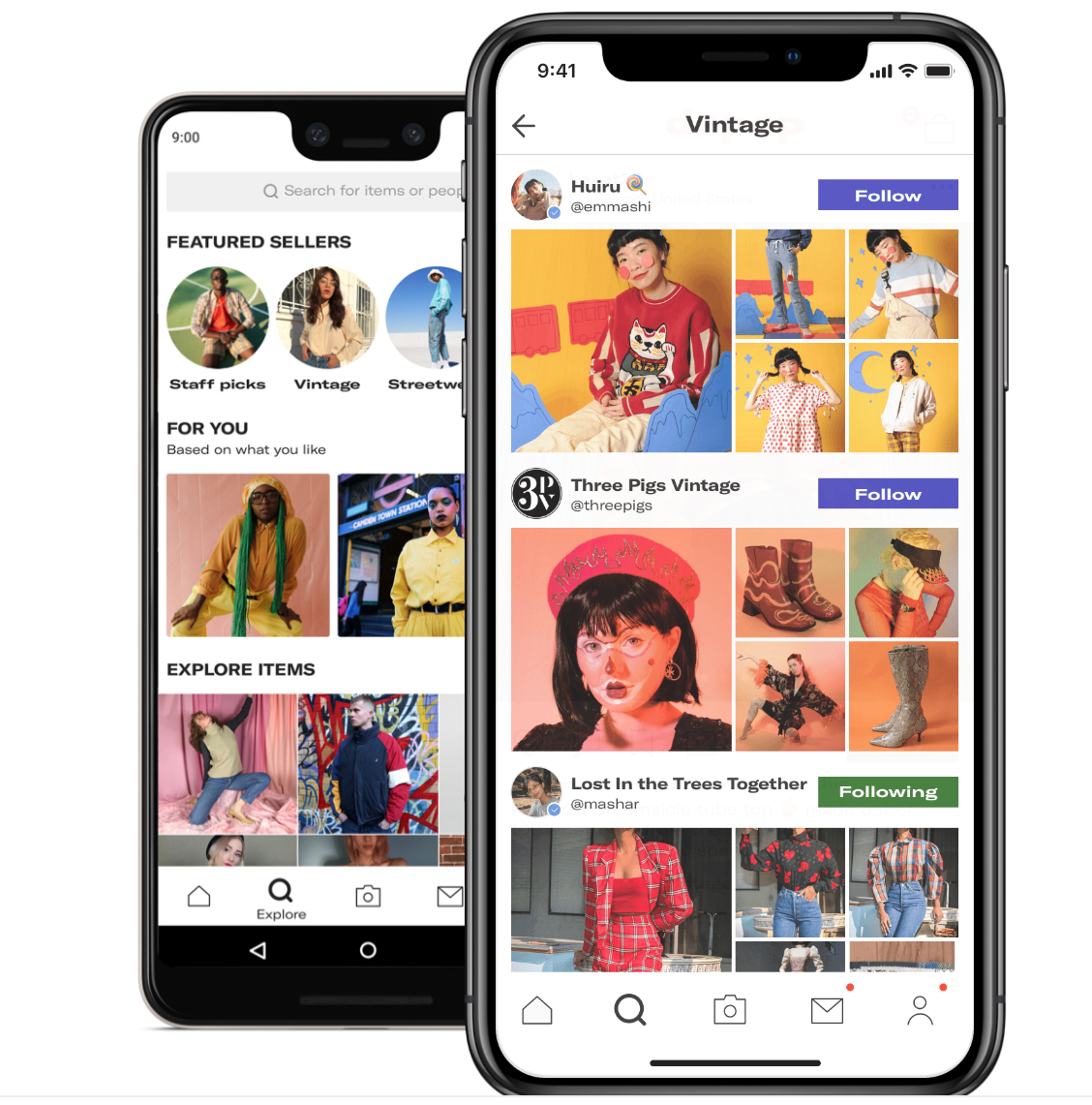
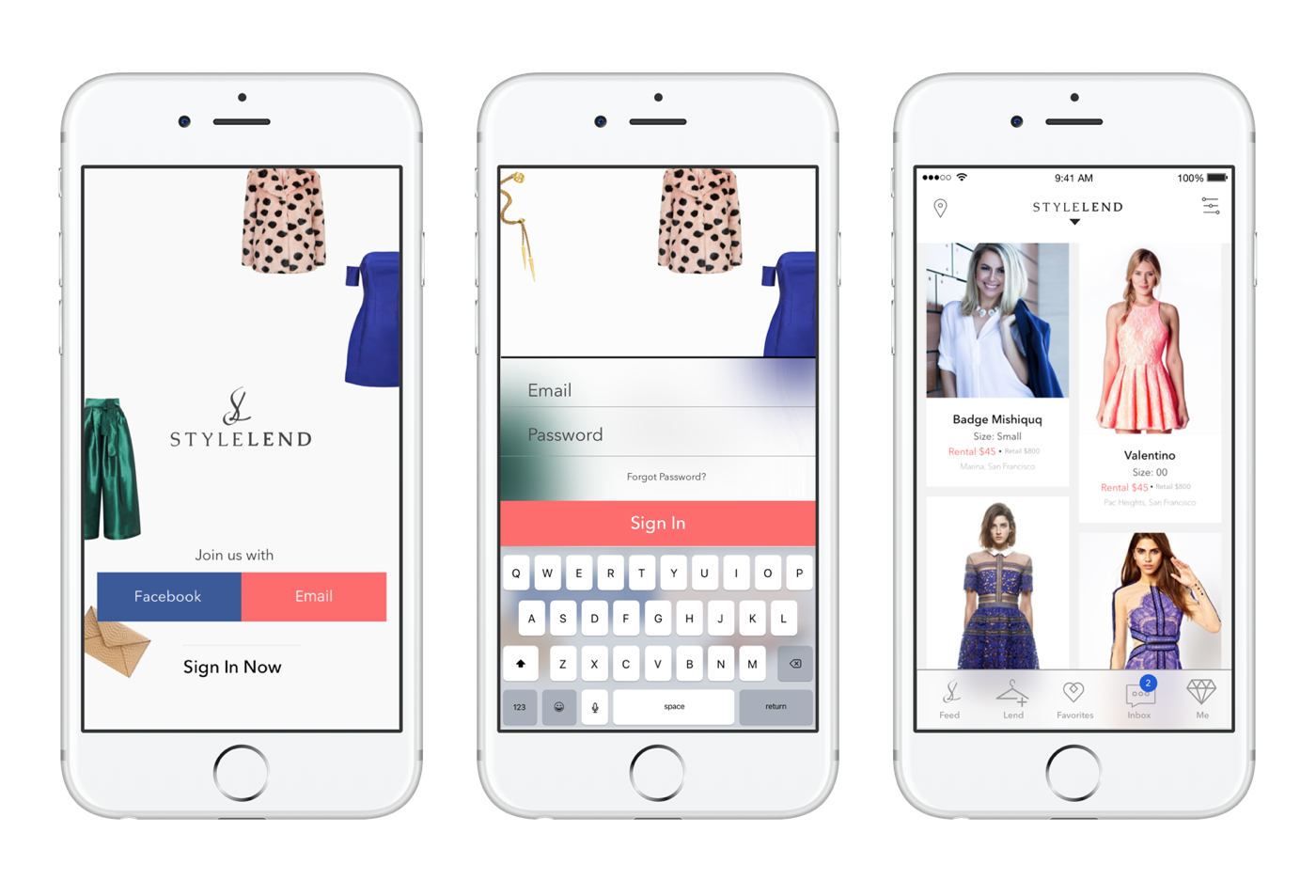
2. Style Lend: This is a peer-to-peer fashion rental marketplace where users can be both providers and consumers. The company uses machine learning to offer personalized recommendations, matching customers with their ideal style & fit. Ultimately, their rental model is more sustainable than purchasing new clothing.
3. Reflaunt: This is a platform which makes resell simple for big retailers. Consumers can resell their past purchases directly on participating brand's e-commerce sites. These items are then connected to a number of global marketplaces, and Reflaunt maintains a connection between the brand and their products using the blockchain.
The secondhand market is only just beginning -- brands who haven't yet ventured into this market need only look at the numbers to be convinced.

Sustainable textiles using innovative technologies
Another digital approach to render the industry more sustainable from the start, rather than at the end of the process like with resell, is the creation of sustainable textiles. The aforementioned digital solutions help to reduce the consumption of:
- Fabrics
- Threads
- Embellishments
- Fibers
Indeed, during the design and manufacturing processes, textile leftovers and throwaways can be a major source of waste for many fashion brands and retailers. According to the EPA, 17 million tons of textile waste ended up in landfills in the US in 2018. Because of the massive waste created by textiles, some brands are using innovative technologies to curb sustainability concerns and cut out the waste problem from the start.
From durable plant-based fabrics to recycling processes, brands are finding new digital solutions to create sustainable resources themselves.
There are two main approaches to creating more sustainable textiles:
1. Recycling: Some brands are transforming used clothing into recycled fibers for new purposes.
- Madewell recycles its brand jeans into housing insulation.
- Wawwa uses recycled cotton to create ethically-made apparel.
Adopting innovative technologies such as these into the design process is a big step toward rendering the industry more sustainable, saving on time, energy, and overproduction.

Wawwa
2. From nature: Other brands are entirely creating their own textiles from raw materials found in nature.
- Flocus uses in-house technologies to transform the Kapok tree into fibers, yarns, fabrics, and non-wovens.
- MycoWorks creates faux leather using agricultural waste and mycelium.
These companies are reworking the value chain by rendering it more circular with ethical manufacturing technologies.
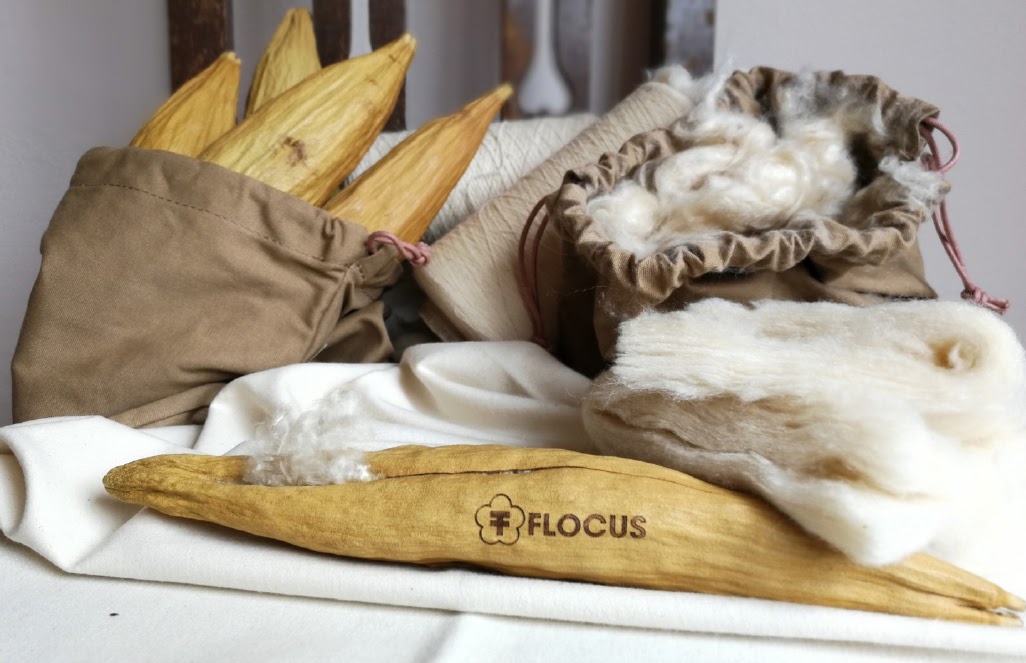
Flocus
Digital fashion: Friendly for the planet
Another route toward a more sustainable industry is via digital fashion. This approach helps to reduce waste, increase efficiency, and streamline resources. Today there are more and more digital fashion brands and even retailers stepping in to create a greener industry.
There are two main approaches to digital fashion:
1. Physical fashion: This approach uses digital design processes to create physical clothing. Digital solutions such as these can be used:
- 3D design software
- Virtual avatars
- Body scans
This clothing is often made-to-order, meaning that nothing is produced until an order is put in, so the issue of overstock is taken out of the equation. Additionally, these digital design tools measure all the materials needed for a piece of clothing, so only what is necessary is used.
This is one example of a brand who uses digital processes to create physical items of clothing:
- Diane von Furstenberg is one fashion brand which uses innovative, tech-based design methods to create physical clothing. The customer puts in an order online, upon which they can immediately see the outcome via 3D model. The clothing is then made-to-order, removing the problem of unsold inventory from the start.

Diane von Furstenberg
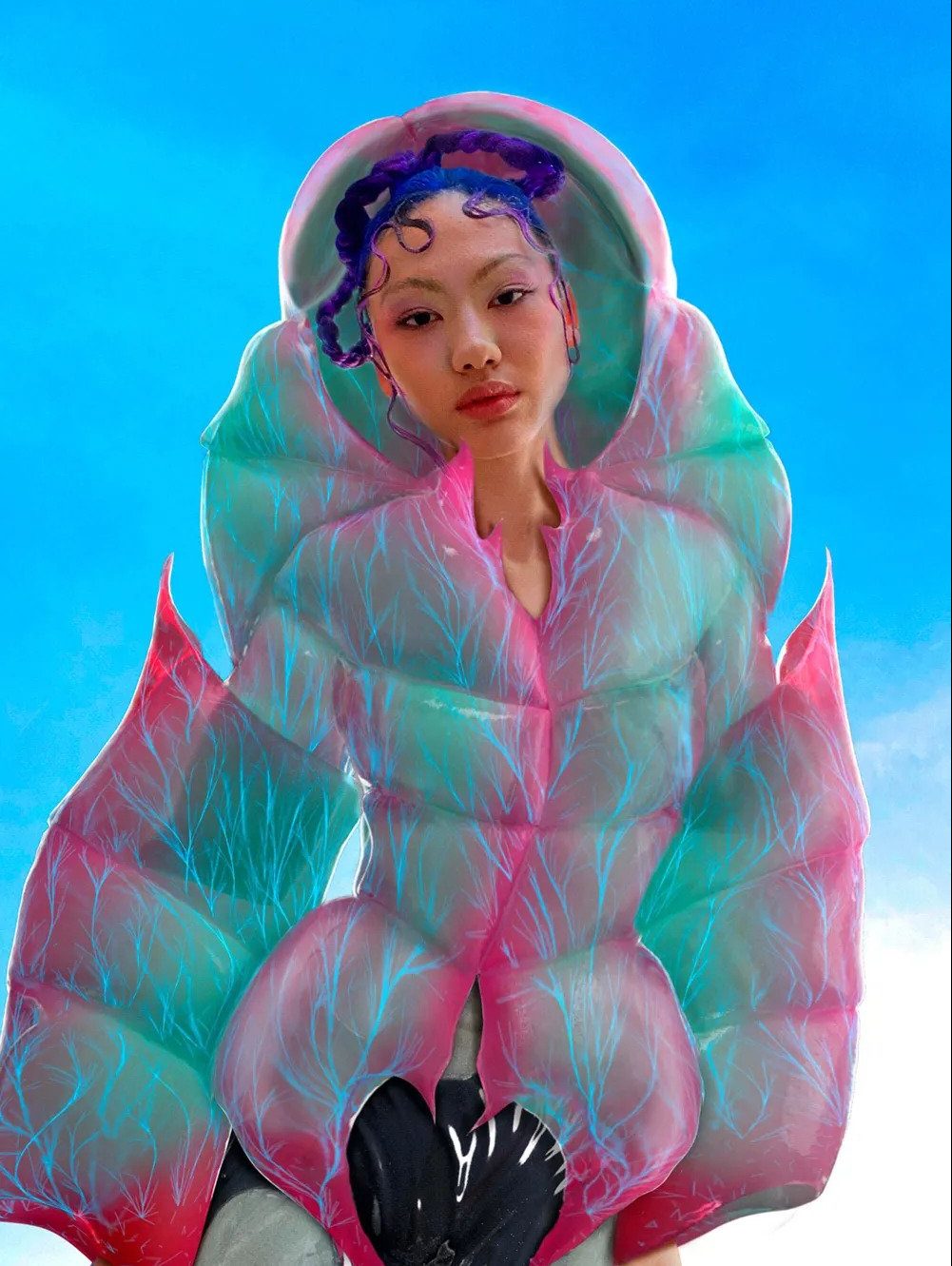
Auroboros
2. Virtual fashion: This is clothing that exists only virtually -- it's a natural progression of the era of social media, virtual collections, and the like. Customers send in a photo of themselves, and the digital apparel is placed on the image. This approach caters to:
- Occasion-wear, in which consumers purchase apparel to only wear once
- Overproduction and waste issues
Here are two examples of brands who create digital clothing:
- The Fabricant is the first ever digital fashion house. They create virtual, 3D garments that are personalized for the customer, and they claim to reduce water use, toxicity, and CO2 emissions.
- Auroboros is a London-based brand which creates digital clothing. Each design is made to measure and added to photographs sent in by the customer. Through these processes, no physical materials are ever used and the issue of waste is avoided from the start.
In The Fabricant's words:
"Transitioning to digital practices not only creates an industry that's less wasteful and less environmentally impactful than ever before, it allows a fashion future that's smarter, more resilient, and better placed to manage uncertainty."
The technologies fashion now has access to are opening up opportunities for sustainability at every step of the collection creation process. When we look at the range of possibilities in digital innovations today, it seems fashion isn't doomed to be unsustainable.
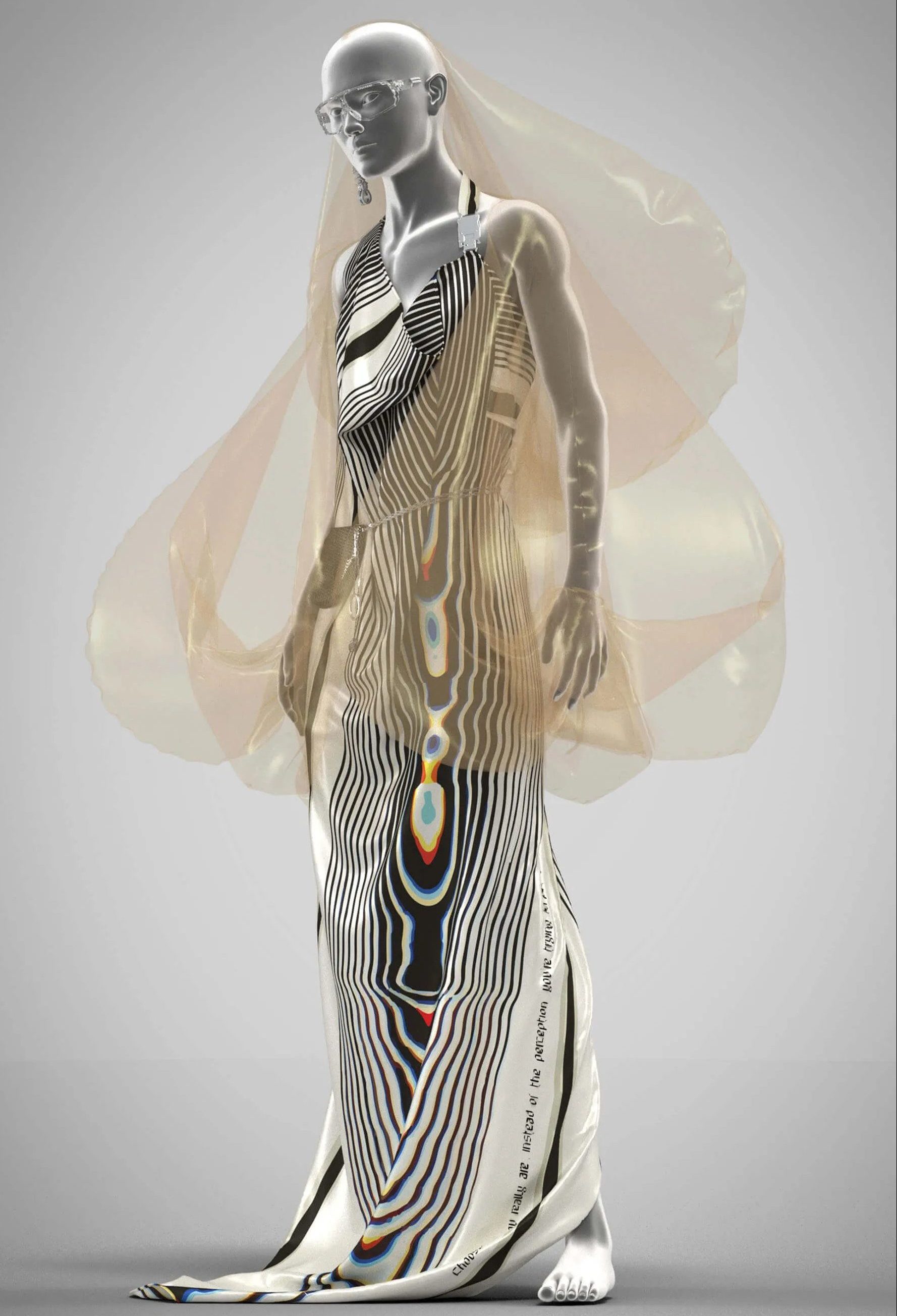

The Fabricant
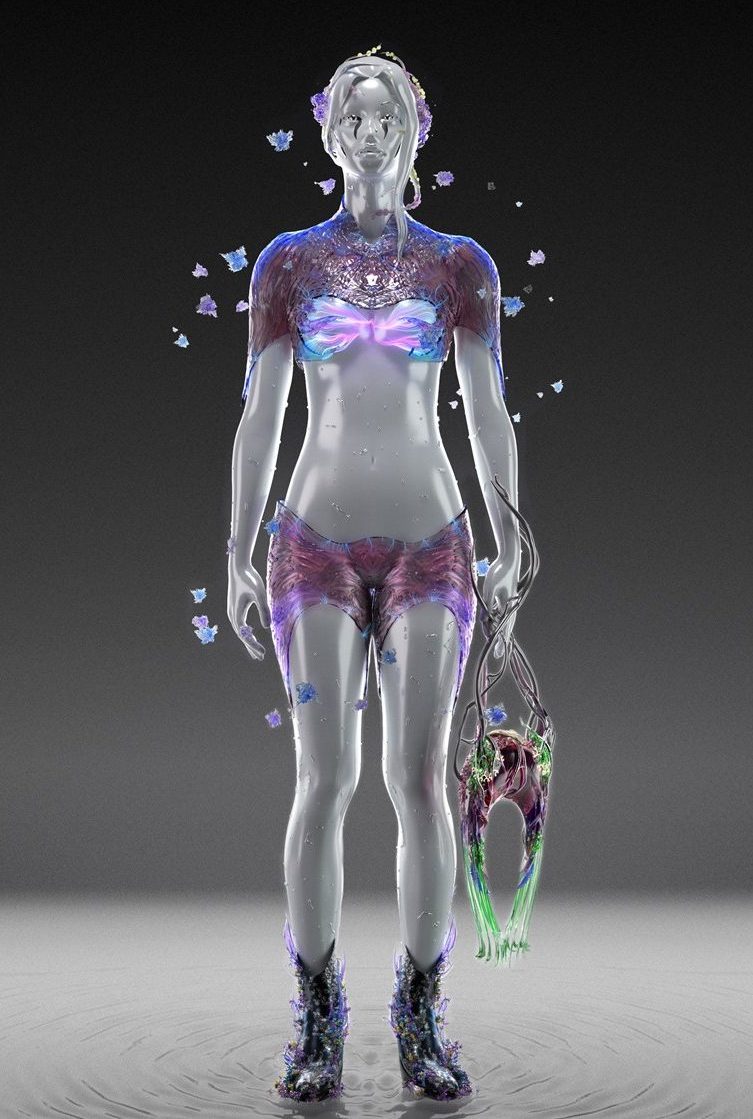
Ultimately, there exist a wide range of avenues toward sustainability in fashion.
1. Resell is a growing industry as new platforms are appearing to facilitate second-hand shopping, and luxury brands are embracing the eco-friendly side effects of reselling past seasons' products.
2. Sustainable raw materials are also rising in popularity with the emergence of new biotechnologies which eliminate the need for traditional sourcing by creating lab-made textiles instead.
3. Digital fashion brands & retailers are challenging the very notion of fashion by digitizing apparel or apparel-making processes, a nod to the fine line between virtual and reality today.
With digital transformation, the path to sustainability is unlocked, and there's plenty of room still. Let's see another way that this transformation is making the fashion industry a better place.
Diversity and inclusivity

Hangna Koh
Under-representation and exclusion have been a motif in the fashion industry for quite some time, but like many archaic aspects of the industry, consumers have been challenging this status quo in big ways over the past year.
Fashion brands, especially big houses, have historically favored models and consumers with Eurocentric beauty standards, leading to a very particular sizing, design, and consumer base. Consumers have had enough. The industry is becoming more diverse and inclusive thanks to:
- The advent of social media
- New technologies
- Changing consumer values
Adaptive fashion: Technology for representation
Adaptive fashion is the modification of clothing to fit the needs of people with disabilities. Fashion has never quite included those with disabilities in their products. This can include a range of design modifications including:
- Snap closings rather than zippers
- Slip-on shoes
- Hidden magnets for fastenings
- Differently-placed openings
The demand for this genre of inclusive clothing is growing, and brands are beginning to respond. According to a Harvard study:
"Businesses that are agile and ahead of the curve in terms of market changes and customer needs are also more socially responsible".
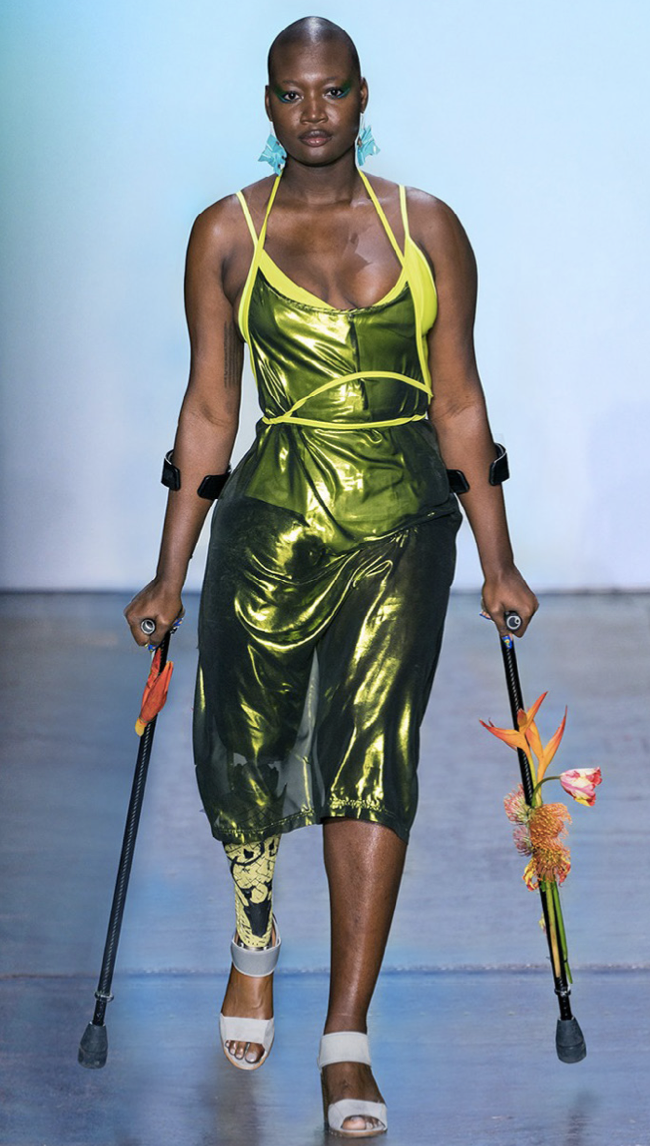
Chromat
Some examples of brands which are stepping into the adaptive fashion space are:
1. Nike: A well-known example of a brand who has moved into adaptive fashion is Nike, who adapted an existing pair of sneakers into a line called FlyEase. They modified their existing manufacturing systems to create a new type of shoe which could be fastened without laces, using a unique closure on the back of the shoe rather than the top.
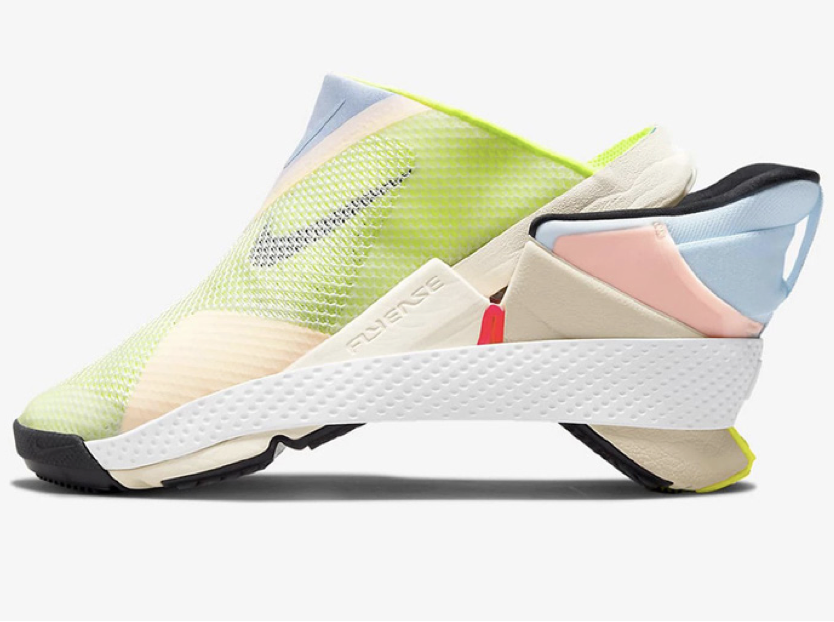
Nike Flyease
2. Billy Footwear: Another brand, albeit less well-known, is Billy Footwear, who adopts Universal Design into their shoes. Universal Design is the concept of creating designs that accommodate all people, and design processes are rendered simple and adaptable. They use this concept to create footwear that is functional and inclusive.
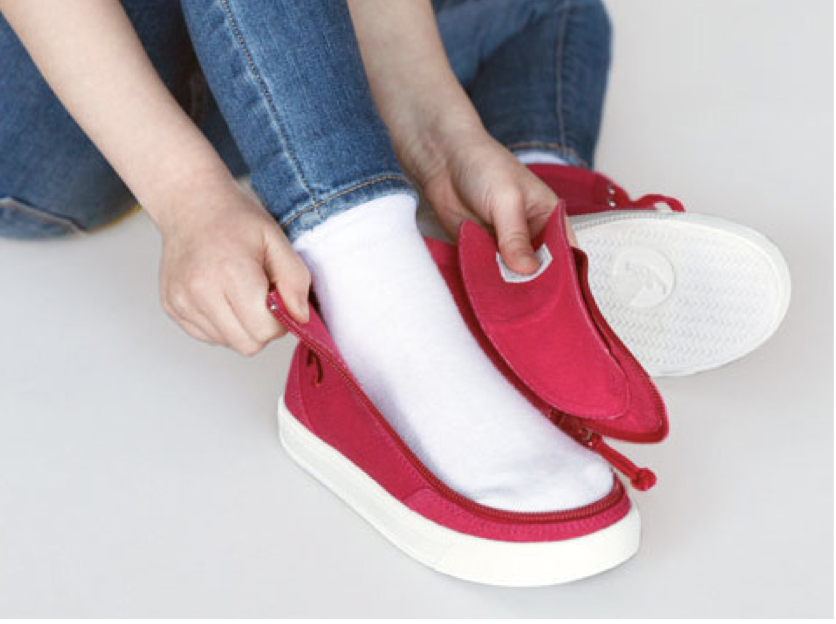
Billy Footwear
For brands who wish to cater to an audience with disabilities, there already exist digital tools to do so, from modified manufacturing processes to new design add-ons. What's more necessary in this digital transformation, though, is a change in mindset toward normalizing inclusivity and the facility that digitalization can bring to the cause. Adaptive clothing is just one facet of inclusive fashion. Consumers are also asking for clothing that is:
- Size inclusive and flattering on different body types
- Tailored to different cultures and religions
- Unisex or genderfluid
It goes without saying that all of these causes are more than worthy, and overdue. Let's look at body-positive fashion as a second example.
Body positive fashion through digitalization
Where digital transformation comes in for body representation is very much through digital fashion. There are more and more emerging designers creating fully-digital clothing, or physical clothing created with innovative digital tools, in order to cater to all body shapes and sizes.
There are two main ways in which digital fashion operates to be body inclusive:
1. Physical clothing: Physical clothing can be fitted to a consumer through 3D design technologies that entirely personalize the cut and silhouette to the consumer.
Hanifa is an example of a physical clothing brand working toward diversity through digitalization. This Congolese fashion brand showcases their clothing on digital 3D models that are digitally-rendered for virtual collections & e-commerce. The consumer receives physical clothing upon ordering. Additionally, the virtual models are fuller-figured, as designer Anifa Mvuemba affirms a "celebration of the country and of its women."
Hanifa proves the viability of digital solutions as a support for physical products and their marketing while providing a platform for inclusivity and diversity.

Hanifa
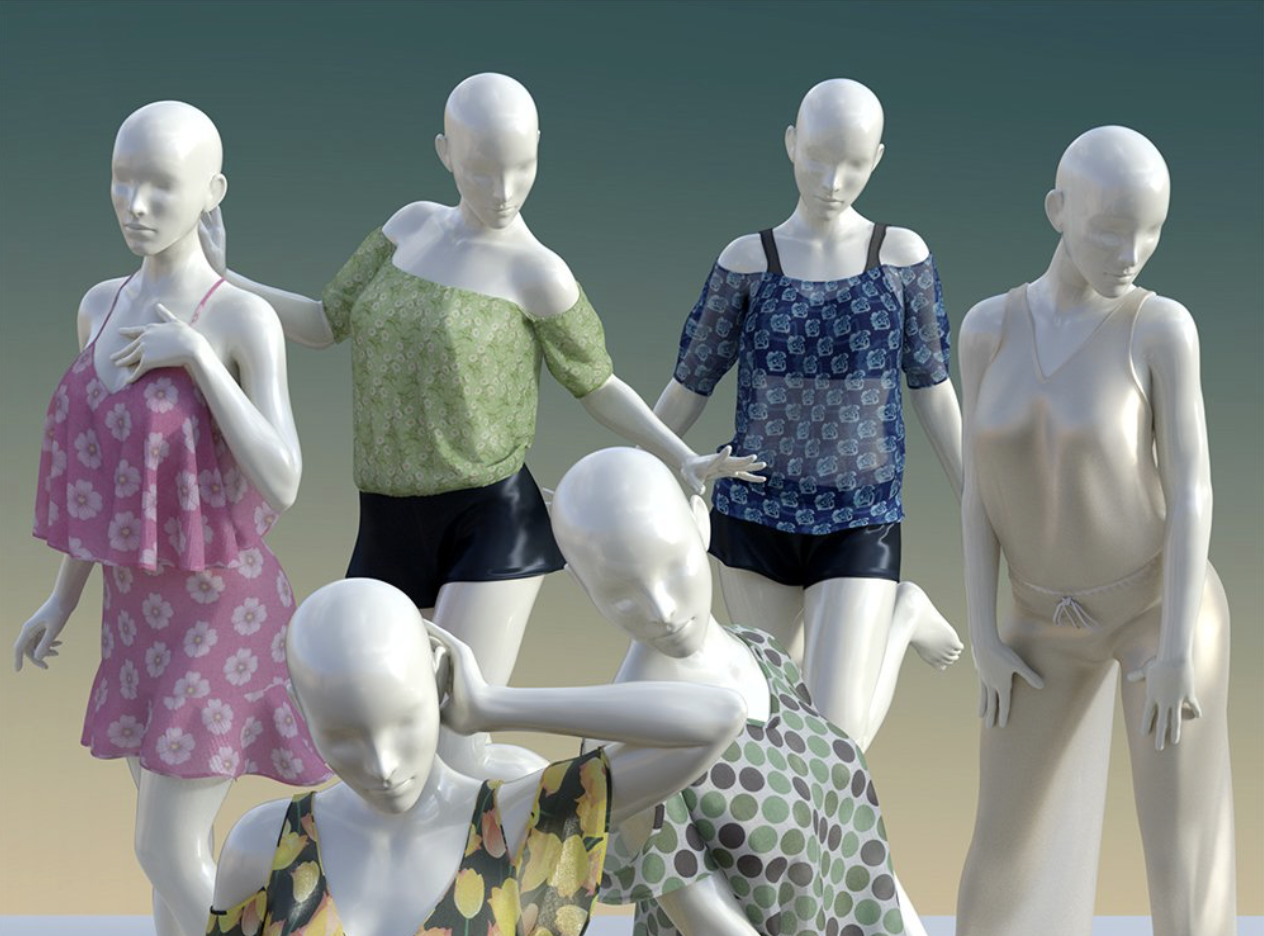
Daz 3D
2. Digital clothing: Digital clothing can be fitted to a consumer by adapting the sizing to the consumer's silhouette.
The Institute of Digital Fashion is an organization with the goal of disrupting the current fashion industry with digital solutions to create a more diverse, inclusive, and sustainable fashion future. They partner with a range of tech companies and fashion brands to meet this objective. One of these companies is Daz 3D:
- 3D-content and software company
- Virtual avatars of real-life consumers
- Caters to all body types including trans, plus-size, and more
Leanne Elliott Young, founder of the Institute of Digital Fashion, explains what the future of fashion looks like:
"The fashion cycle is certainly broken, and digital has absolutely got the opportunity to fix it."
Indeed, we are at a crossroads:
- The current system is highly exclusionary
- Fashion has never been more accessible and democratic
This discrepancy is finally catching up to the industry as diversity, inclusion, and sustainability are being put on the table for all to address. Brands are finally taking action to make fashion a better space for the planet and its people. With digital solutions like 3D design, digital clothing, lab-made fabrics, and more, the future is bright.
The digital transformation of the fashion industry: The sky's the limit
Digital transformation is the process of using digital technologies to create new, or modify existing, business processes, culture, and customer experiences to meet changing business and market requirements. Indeed, the fashion industry is in the age of digital transformation, and it's a necessary progression of its evolution, especially given the current situation.
It is crucial to shape the industry consciously and with purpose, with the hopes of moving toward a sector that is collaborative, streamlined, and self-aware.
Bear in mind, though, that digital transformation will not happen overnight, nor will it happen homogeneously. The digital transformation process is one that is bespoke: it must be tailored to the brand or retailer to fit their specific challenges and goals within their existing framework. The forms of digital transformation and its benefits are many:
- E-commerce is continuing to rise. An accessible and visually appealing online store is the difference between lagging behind and pulling ahead.
- Social media is strengthening B2C relations, reinforcing brand identity and transparency, boosting omnichannel commerce, & increasing sell-through.
- In-store shopping can be boosted with digital solutions in physical stores to accommodate customers' changing desires and expectations.
- The value chain has many stages where digital solutions can add further value to improve efficiency, customer satisfaction, and more.
- Team alignment and evolution are dependent upon a change in mindset and a common language through an effective digital transformation.
- Sustainability efforts and values are being accelerated with innovative technologies anywhere from the design stage to resell.
- Inclusivity and diversity are values which are finally being brought into the light with solutions like virtual fashion and adaptive clothing.
